 Traduzca esta página al español
usar FreeTranslation.com
Traduzca esta página al español
usar FreeTranslation.com 
 Traduire Cette Page A Français
utilisation FreeTranslation.com
Traduire Cette Page A Français
utilisation FreeTranslation.com 
 Übersetzen Sie Diese Seite Zu Deutsch
Gebrauch FreeTranslation.com
Übersetzen Sie Diese Seite Zu Deutsch
Gebrauch FreeTranslation.com 
Ancient History, Archeological
facts and the Bible
Matthew 13:35, Jesus said, "I will utter things
which have been kept secret from the foundation of the world."
He also said, "There is nothing buried that will not be raised!" Does this refer
to the Nag Hammidi scrolls? - The Dead Sea scrolls? The stone tablets of
Nineveh? We think it does.
Secret Knowledge about Moses - Brother to a Pharoah
This story is about the Goddess of Moses.
New archaeological information proves Ramses was not Moses' step-brother. This
information is about secrets during the Exodus.
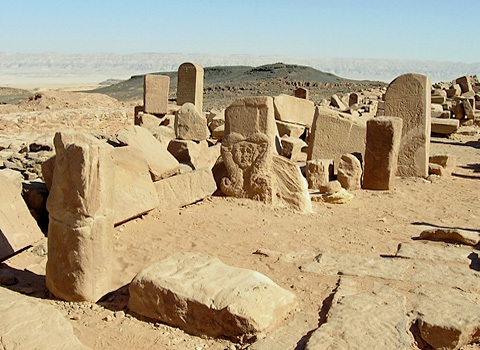 When Moses crossed the desert and went up on the mountain, the God he spoke to wasn't
Jehovah or Yehwah. There was something on the mountain never before admitted to by theologians
because it would blow the lid off of modern Christianity forever. A renowned archaeological researcher
found this site in 1905 on Mount Horeb - dubbed as Gebel Musa, ( Mount of Moses ),
or Horeb, the mountain of Serâbît.
When Moses crossed the desert and went up on the mountain, the God he spoke to wasn't
Jehovah or Yehwah. There was something on the mountain never before admitted to by theologians
because it would blow the lid off of modern Christianity forever. A renowned archaeological researcher
found this site in 1905 on Mount Horeb - dubbed as Gebel Musa, ( Mount of Moses ),
or Horeb, the mountain of Serâbît.
Of cource the Christian community chose to subdue and ignore this information. They chose another mountain
to build a church and proclaim it to be the real Mountain of Moses. They chose
Mount Nebo (Jordan) as the Mountain to build the
Church and proclaim it to be Moses Mountain.
According to the final chapter of Deuteronomy, Mount Nebo is where the Hebrew prophet Moses was given
a view of the promised land that God was giving to the Israelites. "And Moses went up from the plains of Moab to Mount
Nebo, the top of Pisgah, which is opposite Jericho." (Deuteronomy 34:1).
According to Jewish and Christian tradition, Moses was buried on this mountain by God Himself, and his final
resting place is unknown. Scholars continue to dispute whether the mountain currently known as Nebo is the same as
the mountain referred to in the Torah. Now we know why!
According to the 2 Maccabees 2:4-7, the Prophet Jeremiah hid the tabernacle and the Ark of the Covenant here.
On the highest point of the mountain, Syagha, the remains of a church and monastery were discovered in 1933.
The church was first constructed in the second half of the 4th century to commemorate the place of Moses' death. The
church design follows a typical basilica pattern. It was enlarged in the late fifth century A.D. and rebuilt in A.D. 597. The
church is first mentioned in an account of a pilgrimage made by a lady Aetheria in A.D. 394. Six tombs have been found
hollowed from the natural rock beneath the mosaic-covered floor of the church. In the modern chapel presbytery, built to
protect the site and provide worship space, you can see remnants of mosaic floors from different periods. The earliest
of these is a panel with a braided cross presently placed on the east end of the south wall.
HOWEVER, in 1905, Flinders Petrie investigated the afore mentioned site, and found the famous proto-Sinaitic script", which is
believed to be an early precursor of the alphabet. An ancient temple was found on the mountain.
The Temple also contained a ton of white powder.
Moses' Mountain:
The Serabit El Khadim temple looks like a double series of steles leading to an underground
chapel dedicated to the Hathor Goodness. There also are stone tablets similar to the ones Moses
showed the people with the 10 commandments engraved on them. If we track this forward to
King Solomon we see that he worshipped the Goddess Asherah/Astarte/Ashtroeth/Ishtar/Shekina.
Asherah was worshipped in ancient Israel as the consort of El and in Judah as the consort
of Yahweh and Queen of Heaven. "God's Wife".... Hathor (Ht-hr - House of Horus).
Sinai was one of Hathor's domains... and she had many other names, besides.
The cover-up goes all the way back to before Moses'
exodus from Egypt which had a different reason that the one described in Exodus.
Scholars have described Moses as an Egyptian, trained by Egyptian priests. His
knowledge went far beyond the illiterate Hebrew's point of view. God must have had
a reason for using this brilliant, highly educated man for his purpose.
God's Wife or the Feminine Goddess
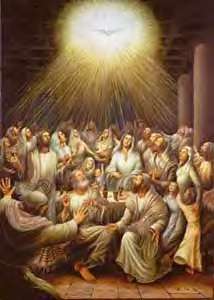 She is found in many forms within Esoteric Christianity.
We see her as Asherah, the great Canaanite Goddess worshiped early on in the
Hebrew tribe. We see her as Shekinah, the Feminine Presence of Godhead and Great
Mother. We see her as Mary, the incarnation of Shekinah and Mother of Yeshua, the
Queen of Heaven and Earth and our Mediatrix. Sometimes we see Her in the images
of Sophia and Mary Magdalene, though They are most often associated with the
Daughter Goddess. We see Her in Eloah, feminine counterpart of El, present and
active at creation. We see Her throughout all time in many forms, but through
past, present, and future She will always be simply, Our Mother.
She is found in many forms within Esoteric Christianity.
We see her as Asherah, the great Canaanite Goddess worshiped early on in the
Hebrew tribe. We see her as Shekinah, the Feminine Presence of Godhead and Great
Mother. We see her as Mary, the incarnation of Shekinah and Mother of Yeshua, the
Queen of Heaven and Earth and our Mediatrix. Sometimes we see Her in the images
of Sophia and Mary Magdalene, though They are most often associated with the
Daughter Goddess. We see Her in Eloah, feminine counterpart of El, present and
active at creation. We see Her throughout all time in many forms, but through
past, present, and future She will always be simply, Our Mother.
Another interesting thing about Hathor is found in one particular Egyptian tale - when
the hero of the story was born, the 'Seven Hathors', disguised as seven young women,
appeared and announced his fate. They seemed to be linked with not only fortune telling,
but to being questioners of the soul on its way to the Land of the West. These goddesses
were worshiped in seven cities: Thebes, Heliopolis, Aphroditopolis, Sinai, Memphis,
Herakleopolis, and Keset. They are linked to the
Pleiades Star Cluster.
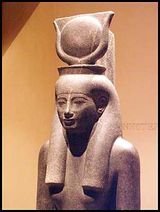 Generally, Hathor is pictured as a woman with cow's horns with the sun between
them (Eye of Ra, Golden One), or as a beautiful woman with cow's ears, or a cow wearing
the sun disk between her horns, or even as a lioness or a lion-headed woman
(destruction and drunkeness). She often is seen carrying a sistrum, an ancient
musical instrument (hence a goddess of music). The sycamore was sacred to her
(Lady of the Southern Sycamore). She is said to be the mother of the pharaoh,
and is often depicted in a nurturing role, suckling the pharaoh when he was a child
(hence a goddess of motherhood).
Generally, Hathor is pictured as a woman with cow's horns with the sun between
them (Eye of Ra, Golden One), or as a beautiful woman with cow's ears, or a cow wearing
the sun disk between her horns, or even as a lioness or a lion-headed woman
(destruction and drunkeness). She often is seen carrying a sistrum, an ancient
musical instrument (hence a goddess of music). The sycamore was sacred to her
(Lady of the Southern Sycamore). She is said to be the mother of the pharaoh,
and is often depicted in a nurturing role, suckling the pharaoh when he was a child
(hence a goddess of motherhood).
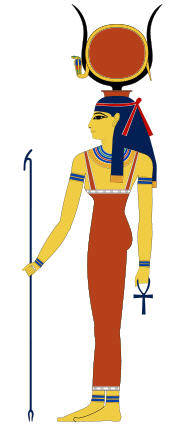 Ishtar/Astarte was the Semitic goddess of love.
A king was required to marry the goddess if he were to be considered the
country's true leader. The king was not such without the queen.
The earliest known legend about this is with Egyptian Queens as they were
considered, 'God's wife' but it may be much older. Her name translates
to "The House of Horus," and so she is associated with the Egyptian royal family.
We discuss this more on our 'Passage of Secrets', page 2 and Forbidden 4.
Ishtar/Astarte was the Semitic goddess of love.
A king was required to marry the goddess if he were to be considered the
country's true leader. The king was not such without the queen.
The earliest known legend about this is with Egyptian Queens as they were
considered, 'God's wife' but it may be much older. Her name translates
to "The House of Horus," and so she is associated with the Egyptian royal family.
We discuss this more on our 'Passage of Secrets', page 2 and Forbidden 4.
Much of the complex of the sanctuary of Ptah, to the south of the Cave of Hathor, was
reconstructed during a later building phase, though it originally dates to Amenemhet III and IV.
The approach contains remains of a pair of sphinxes of Tuthmose III as the Tuthmoside kings
replaced the Ptah sanctuary with a new chapel dedicated to Hathor, Amun of Thebes and Soped.
The interior of the Soped shrine has a niche in the rear wall, but nothing of the decoration
completed by Rameses IV and VI can now been seen there. However there are some interesting
statue fragments and stelae standing outside the shrine. Even when walking the ancient
processional paths used by the priests during their daily cult rituals, I found this is a difficult
temple to imagine in everyday use. The difference in topography between the Middle Kingdom
and New Kingdom levels, along with the mounds of rubble and stone blocks and the forest of
standing stelae now open to the scorching desert sun no longer feels like a temple but is no
less fascinating to those of us who love to read the stones. see
Serabit
Christians theologists will not acknowledge this find or
the evidence it presents about Moses. The Temple was dedicated to Hathor
and only one initiated into "the Mysteries" could assend the mountain.
At that time, the Jews had never heard of Jehovah; they worshipped the goddess
Asherah and their spiritual leaders were largely female. Indeed, Miriam posed such
a problem for Moses in his attempt to create a new environment of male dominance
that he imprisoned her, whereupon the Israelites rose up against Moses to secure
Miriam’s release. This is in the
book of Jasher,
but it is not in the Bible.
What else did biblical scholers get wrong?
The Temple was dedicated to Hathor who was associated with; Ptah, Ra, Enki, Marduk,
Isis, Thoth, ect.. Restoration work was done by Queen Hatshepsut, along with Tuthmosis
III and Amenhotep III during the New Kingdom.
The mountain now generally known as Mount Sinai sits in the south of the peninsular - quite near
to the bottom point of the upturned triangle - and it was given its name in the 4th century by
a mission of Greek Christian monks 1700 years after the time of Moses. It is now sometimes
called Gebel Musa (or Mount of Moses) and there is still a Christian retreat there called St
Catherine's Monastery. However, this is not the Sinai mountain which the Bible calls Mount Horeb.
The book of Exodus goes into some detail to explain the route taken by Moses and the Israelites
from the Egyptian Nile delta land of Goshen - down across the wilderness regions of Shur and
Paran in northern Sinai, to the land of Midian (which is to the north of present-day Jordan).
From this route it becomes very easy to identify the location of Mount Horeb, which sits a good
deal north of Gebel Musa. The word Horeb simply means 'desert', and the great desert mountain
which soars to over 2600 feet within a high stone plateau above the Plain of Paran is today
called Serâbît el-Khâdim (the Prominence of the Khâdim).
In the late 1890s, the British Egyptologist Sir William Flinders Petrie, a professor at the
University College, London, applied to the Egypt Exploration Fund to take an expedition into
Sinai. By January 1904, his team had departed and in the March of that year they took their
expedition to the heights of Mount Serâbît. In the following year Petrie published the detailed
results of his findings, but added to his report the fact that, to his dismay, this information
would not be made available to the Egypt Exploration Fund subscribers who would receive
only maps and a general outline. Furthermore, Petrie explained that, from the time of that
Sinai expedition (even though he had taken previously funded teams into Egypt), his
sponsorship by the Fund was terminated - ostensibly because he had broken the binding
rule of the Articles by divulging something which was contrary to Bible teaching. He had,
in fact, discovered the great secret of the sacred mountain of Moses - a secret which
not only made sense of the Exodus portrayals, but which blew the lid totally from their
common scriptural interpretation. see Genesis 4
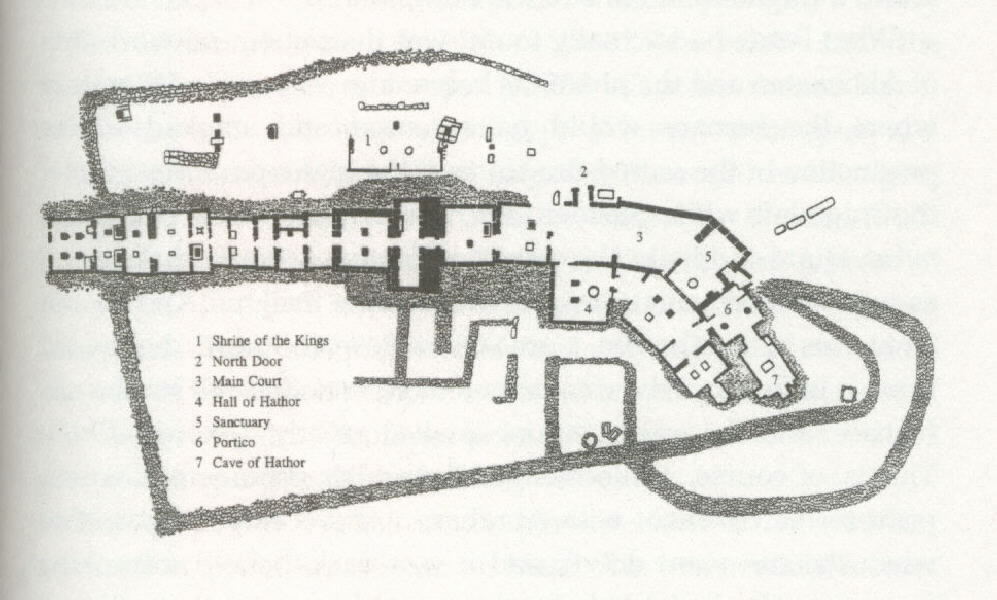 What they found was an enormous temple complex. Set within an
enclosure wall was an outer temple, built over an expanse of 230
feet (approx. 70 metres). This extended outwards from an inner
temple cut within a great cave in the mountainside. Dubbed as
Gebel Musa,( Mount of Moses ). It is 2,600 feet
above the Plain of Paran. Built over an expance of 230 feet,
extending from a great man made cave, they found the ruin of
an old temple. From the various cartouches, carvings and
inscriptions it emerged that the temple had been in use from as
far back as the time of Pharaoh Sneferu, who reigned about 2600
BC and whose immediate successors are reckoned to have built the pyramids of Gizeh.
What they found was an enormous temple complex. Set within an
enclosure wall was an outer temple, built over an expanse of 230
feet (approx. 70 metres). This extended outwards from an inner
temple cut within a great cave in the mountainside. Dubbed as
Gebel Musa,( Mount of Moses ). It is 2,600 feet
above the Plain of Paran. Built over an expance of 230 feet,
extending from a great man made cave, they found the ruin of
an old temple. From the various cartouches, carvings and
inscriptions it emerged that the temple had been in use from as
far back as the time of Pharaoh Sneferu, who reigned about 2600
BC and whose immediate successors are reckoned to have built the pyramids of Gizeh.
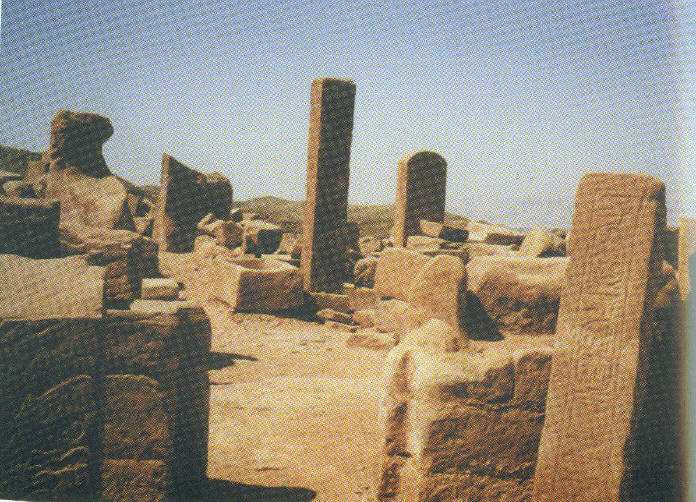 The above-ground part of the temple was constructed from
sandstone quarried from the mountain and it comprised a series
of adjoined halls, shrines, courts, cubicles and chambers. Of
these, the key features unearthed were the main Sanctuary, the
Shrine of Kings, the Portico Court, and the Hall of the goddess
Hathor (to whom the whole complex was dedicated).
The above-ground part of the temple was constructed from
sandstone quarried from the mountain and it comprised a series
of adjoined halls, shrines, courts, cubicles and chambers. Of
these, the key features unearthed were the main Sanctuary, the
Shrine of Kings, the Portico Court, and the Hall of the goddess
Hathor (to whom the whole complex was dedicated).
They found a Semitic altar stone and determined this
to be a vast Egyptian Temple of 'some importance'. The
artifacts were removed, deposited here and there until
few remained to be researched. The discovery was viewed
with displeasure at the time because it contradicted the
Exodus portrayal of the events on the holy mountain.
The funding party also had an objective of 'elucidating or
illustrating the Old Testament', and the discovery
contravened this completely, on it's interpreted version.
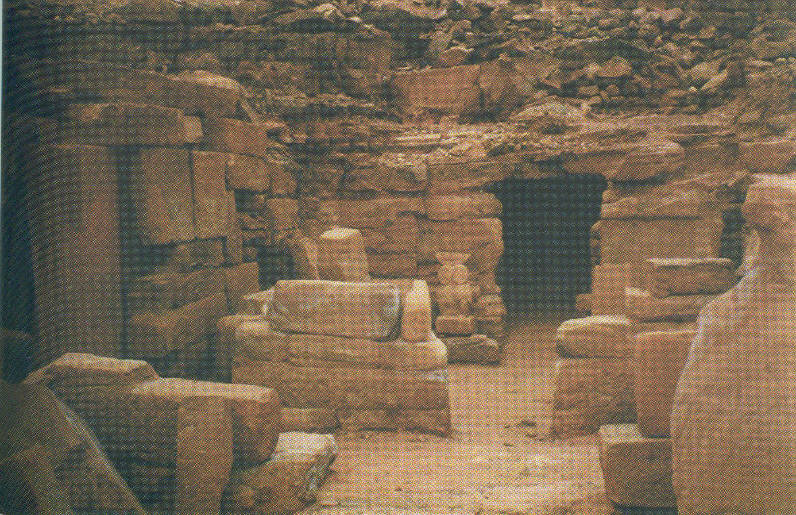 In short, this meant that if something was found which
could be used to support the scriptural teaching, then we (the
public) would be informed. Anything which did not support the
Church interpretation of the Bible was not destined to see the
light in the public domain.
In short, this meant that if something was found which
could be used to support the scriptural teaching, then we (the
public) would be informed. Anything which did not support the
Church interpretation of the Bible was not destined to see the
light in the public domain.
It was, in fact, Pharaoh Tuthmosis III who had reorganized the ancient mystery
schools of Thoth and founded the Royal School of the Master Craftsmen at Karnak.
They were called the Great White Brotherhood because of their preoccupation with a
mysterious white powder. A branch of this fraternity became especially concerned with
medicines and healing, to become known as the Egyptian Therapeutate. Then, in much
later times, the activities of the Therapeutate were extended into Palestine - especially
into the Judah settlement of Qumrân, where they flourished as the Essenes.
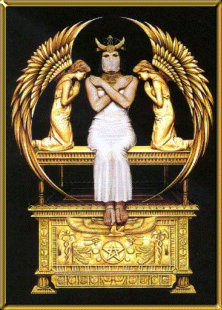 But, what was so special about the goddess Hathor that she was the chosen deity of the
Sinai priests? Hathor was a paramount nursing goddess and, as the daughter of Ra, she was
said to have given birth to the sun. She was the originally defined Queen of the West and
Mistress of the Netherworld, to where she was said to carry those who knew the right spells.
She was the revered goddess of love, tombs and song - and it was from the milk of Hathor
that the pharaohs were said to gain their divinity, becoming gods in their own right.
But, what was so special about the goddess Hathor that she was the chosen deity of the
Sinai priests? Hathor was a paramount nursing goddess and, as the daughter of Ra, she was
said to have given birth to the sun. She was the originally defined Queen of the West and
Mistress of the Netherworld, to where she was said to carry those who knew the right spells.
She was the revered goddess of love, tombs and song - and it was from the milk of Hathor
that the pharaohs were said to gain their divinity, becoming gods in their own right.
On one of the rock tablets near to the Mount Serâbît cave entrance is a
representation of Tuthmosis IV in the presence of Hathor. Before him are two
offering-stands topped with lotus flowers, and behind him is a man bearing a
conical cake identified as white bread. Another relief details the mason Ankhib
offering two conical bread-cakes of shem-an-na to the king, and there are
similar portrayals elsewhere in the temple complex. One of the most significant
perhaps is a depiction of Hathor and Pharaoh Amenhotep III. The goddess holds
a necklace in one hand, while offering the emblem of life and dominion to the
pharaoh with the other. Behind her is the treasurer Sobekhotep, who holds in
readiness a conical cake of white bread. Most importantly in this portrayal,
however, is the fact that Treasurer Sobekhotep is described as the 'Overseer
of the secrets of the House of Gold, who brought the noble and precious
stone to his majesty'.
463 items were removed. These included; large obelisks,
and stelae to small wands and bowls. There are offering
tables, statues, and an altar along with vases, amulets,
plaques and tools. The various pharaonic cartouches
and inscriptions denote an extended time frame from the
4th dynasty through the Middle Kingdom (with a particular
emphasis on the 12th dynasty), the new Kingdom (especially
the 18th dynasty time of Moses) to the Ramesside era,
culminating with the 20th dynasty. This represents an
operative use of the temple through about 1,500 years.
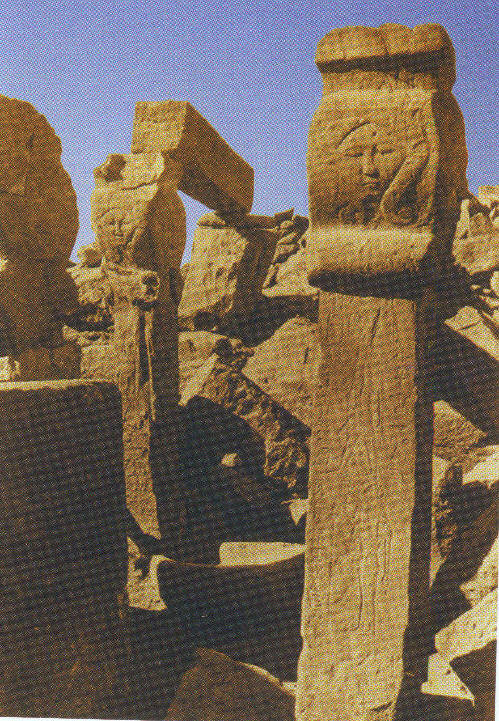 The temple was dedicated to the goddess Hathor throughout
its operative life. (look closely to see the face carved into the rock)
It appears to have ceased function
in the 12th century BC, when Egypt fell into financial decline
and to outside influences, leading to the Greek rule of
Ptolmemies. Deep within the cave Petrie found a limestone
stela of pharoah Rameses I, who had described himself as
"The ruler of all that Aten embraces". Also found was an
Amarna statue-head of Akhenaten's mother, Queen Tiye, with
her cartouche set in the crown. On a previous page we said
we thought Rameses secretly worshiped one god because a
statue of him found upside down and buried in the desert
sand depicted him on one side and Aten on the other.
The temple was dedicated to the goddess Hathor throughout
its operative life. (look closely to see the face carved into the rock)
It appears to have ceased function
in the 12th century BC, when Egypt fell into financial decline
and to outside influences, leading to the Greek rule of
Ptolmemies. Deep within the cave Petrie found a limestone
stela of pharoah Rameses I, who had described himself as
"The ruler of all that Aten embraces". Also found was an
Amarna statue-head of Akhenaten's mother, Queen Tiye, with
her cartouche set in the crown. On a previous page we said
we thought Rameses secretly worshiped one god because a
statue of him found upside down and buried in the desert
sand depicted him on one side and Aten on the other.
The adjoining Cave of Hathor was carved into the natural rock, with flat inner walls
that had been carefully smoothed. In the centre from about 1820 BC) stood a large upright
pillar of Pharaoh Amenemhet III, the son-in-law of Esau. Also portrayed were his senior
chamberlain and his seal-bearer. Deep within the cave Petrie found a limestone stela
of pharaoh Ramesses I - a slab upon which Ramesses (who is traditionally reckoned by
Egyptologists to have been an opposer of the Aten cult) surprisingly described himself
as 'The ruler of all that Aten embraces'.
Some of the mysterious powder was taken back to Britain for analysis and examination,
but no results were ever published. The rest was left open to the elements after 3000 years
to become a victim of the desert winds. What has become apparent, however, is that this
powder was seemingly identical to the ancient Mesopotamian fire-stone or shem-an-na -
the substance that was made into bread-cakes and used to feed the Light-bodies of the
Babylonian kings and the pharaohs of Egypt. This, of course, explains the temple inscriptions
denoting the importance of bread and light, while the white powder (the shem-an-na) has
been identified with the sacred manna that Aaron placed in the Ark of the Covenant.
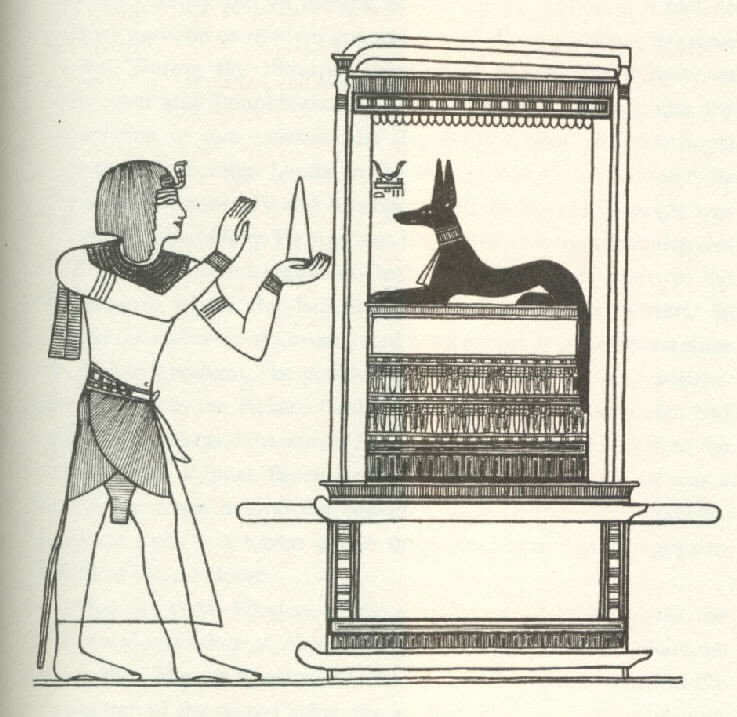 In his writing Eirenaeus described the gold as being
"digested", a word closely associated with "consumed"
(as in the Moses story). The Temple contained a ton of white
powder. The stelae to the right is inscribed, "The presenting of a
white bread that he may be given life". Another stelae shows
Amenhotep offering a conical loaf to the god Sopdu, and states;
"He gave the gold of reward; the mouths rejoiced". From these,
it is clarified that the white powder bread was preceived as a
giver of life, and that it was indeed made from gold. The gold
and the powder was also described in ancient Mesopotamia
and associated with a group of platinum and gold metals
and was called shem-an-na. This means the same as
mfkzt and it interupted as a 'highward fire-stone'.
In his writing Eirenaeus described the gold as being
"digested", a word closely associated with "consumed"
(as in the Moses story). The Temple contained a ton of white
powder. The stelae to the right is inscribed, "The presenting of a
white bread that he may be given life". Another stelae shows
Amenhotep offering a conical loaf to the god Sopdu, and states;
"He gave the gold of reward; the mouths rejoiced". From these,
it is clarified that the white powder bread was preceived as a
giver of life, and that it was indeed made from gold. The gold
and the powder was also described in ancient Mesopotamia
and associated with a group of platinum and gold metals
and was called shem-an-na. This means the same as
mfkzt and it interupted as a 'highward fire-stone'.
The book of Exodus relates that the Master Craftsman who made the original
shewbread for Moses in Sinai was Bezaleel, but Bezaleel was not a baker, he was a noted
goldsmith - the very man who made the golden accoutrements for the Tabernacle and
the Ark itself. This conforms precisely with the function of the priestly Master Craftsmen
in Mesopotamia - the vulcans and metallurgists of Tubal-cain who manufactured the
valuable shem-an-na from pure gold. As for the crucible, the conical stones and the great
array of tanks, tables and equipment which made the Sinai temple appear more like a
gigantic laboratory than a church, it emerges that this is precisely what it was.
In Exodus we read that Moses took the golden calf, which the Israelites had made,
and burnt it in the fire, and ground it to a powder' This is precisely the process of a
shem-an-na furnace and it is evident that the Egyptian priests of the goddess Hathor
had been working their fire for countless generations before the priests of Aten
became involved in the time of Moses.
The church supressed this information when it was confirmed by other reasearchers.
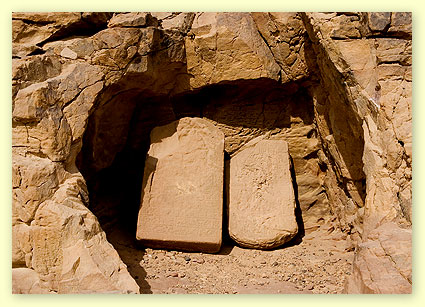 That explains why the 10 commandments were given to Moses. There is a secret
text that explains what Moses was trying to do... he did not succeed. His successor
Josuha had the same problem with the Israelites....They worshiped Baal, Elohim, Enlil
or a 'different god'.
That explains why the 10 commandments were given to Moses. There is a secret
text that explains what Moses was trying to do... he did not succeed. His successor
Josuha had the same problem with the Israelites....They worshiped Baal, Elohim, Enlil
or a 'different god'.
A strange white powder
A scientific discovery by American
David Radius Hudson
in his own back yard in 1986, called the 'white powder of projection', also tells us what Moses
made the Hebrews eat. The story of Mr. Hudson’s efforts over the years is given in the form
of a rough transcript of his presentation in 1995 at the International Forum on New Science in
Fort Collins, Colorado. As such, it serves as an excellent introduction to the study of the ORME,
and its immense implications. His story and the profound revelations of his work are well
worth considerable study. The white powder found on the Mt. of Serâbît is
the same as what Mr. Hudson found on his own property.
Christians theologists will not acknowledge this find or
the evidence it presents about Moses. The Temple was dedicated to Hathor
and only one initiated into "the Mysteries" could assend the mountain.
One of many 'Hidden Secrets'
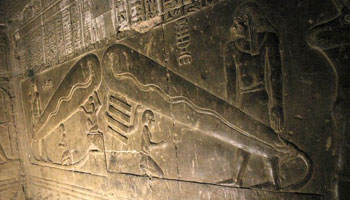
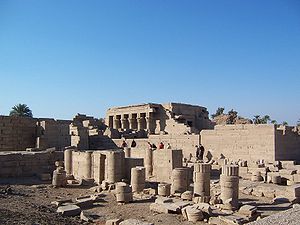
Beneath the Temple of
Hathor at Dendera
there are inscriptions depicting a bulb-like
object which some have suggested is reminiscent of a "Crookes tube" (an early lightbulb).
Inside the "bulbs" a snake forms a wavy line from a lotus flower (the socket of the bulb).
A "wire" leads to a small box on which the air god is kneeling. Beside the bulb stands a
two-armed djed pillar, which is
connected to the snake, and
a baboon bearing two knives. In "The Eyes of the Sphinx", Erich Von Daniken suggested
that the snake represented the filament, the djed pillar was an insulator, and the tube
was in fact an ancient electric light bulb. The baboon was apparently a warning that
the device could be dangerous if not used correctly.
Hathor, who among her many other attributes, was the patron goddess of copper
and turquoise miners. It is the only temple we know of built outside mainland Egypt
and mostly dedicated to Hathor. The earliest part of the main rock cut Hathor Temple,
which has a front court and portico, dates to the 12th Dynasty. The temple was
probably founded by Amenemhet III, during a period of time when the mines were
particularly active. The 12th Dynasty was a period of considerable mineral wealth
for Egyptians and some of the finest jewelry from Egypt's past have been discovered
in the tombs of 12th Dynasty women.
At that time, the Jews had never heard of Jehovah; they worshipped the goddess
Asherah and their spiritual leaders were largely female. Indeed, Miriam posed such
a problem for Moses in his attempt to create a new environment of male dominance
that he imprisoned her, whereupon the Israelites rose up against Moses to secure
Miriam’s release. This is in the
book of Jasher,
but it is not in the Bible.
Again in Chapter 1:
"Let US make man in OUR image, after OUR likeness".
Obviously the find was surpressed by Christian scholars, as well as the Book
of Jasher, in which we find a contridicting story about what Moses taught the people.
All is revealed on our page about Moses and that connects to the Ark of the Covenant
which had a secret purpose too.
Hyksos (Hebrew) History
Since our modern Bible and the Hebrew texts come from the Torah of Moses,
we need to examine the actual historical record. Unfortunately this record contridicts
the bible about certain heroes and in many places. The most important one is the
'occupation' of Egypt by the Syrian Hebrew descendents of Abraham. When Abraham
arrived at his new home the people living there served other gods in Egypt.(Joshua 24:2)
This arrival is thought to be around 1780BC.
The Egyptians didn't like the invaders but tolerated them to keep the piece.
They called them Hyksos but they also called them robbers and theives. Perhaps
they were 'the grave robbers' of Egyptian history.
Perhaps one of the greatest contribution of the Hyksos was
the preservation of famous Egyptian documents, both literary and scientific. During the
reign of Apophis, the fifth king of the “Great Hyksos,” scribes were commissioned to
recopy Egyptian texts so they would not be lost. One such text was the
Edwin Smith Surgical Papyrus.
This unique text, dating from about 3000 BC, gives a clear perspective of the human body
as studied by the Egyptians, with details of specific clinical cases, examinations, and
prognosis. The Westcar Papyrus preserved the only known version of an ancient Egyptian
story that may have otherwise been lost. Other restored documents include the Rhind
Mathematical Papyrus, the most important mathematical exposition ever found in Egypt.
But it was the diffusion of innovations with more obvious military applications, such as
bronze-working, which went far to compensate for the technological backwardness of
Middle Kingdom Egypt, and it was these advantages that eventually allowed the kingdom
at Thebes to gain back control of the Two Lands. The biblical version does not seperate
the two kingdoms but it does use the word 'pharoah' to make reference to their own ruler
who controlled the city of Avaris (Ramsses). This is described in detail by
Manetho. and see
Kelly L. Ross PhD- Hyksos XV Dynasty
see the 3rd section of the page,"The Second Intermediate Period of Egypt".
Apophis (Apepi 1) was the second to the last recorded king (1581- 1541 BC.) of the
Hebrews (in Avaris) to hold power. After him is Khamudi/Apepi II (Aphôphis), who only ruled
for one year. During the Apepi rule Seqenenre Tao who lived 400 miles to the south at
Thebes, was murdered in 1554 BC. The Hiram Key suspects that Joseph ruled during this
time period taking the name of the last pharoah of the Hyksos. Joseph's
epilet signature ring was found at Avaris in an archaeological dig in 2006. Egyptian-style
signet rings uncovered in the Hyksos capital of Avaris (30°47'14.71"N, 31°49'16.92"E)
that read "Yakov/Yakub" (from Yaqub-her), similar to the Hebrew name of the Biblical
patriarch Jacob (Ya'aqov).
According to recent archaeological evidence which confirm
the Knight and Lomas' theory,
King Seqenenre Tao II
is the King whose son Ahmose
made slaves of the Hebrews (called Hyksos at the time) and ran them
out of Egypt at the time of the Exodus. According to historian Josephus, and recorded in the
Antiquities of the Jews,
Ahmose had a little help with this task because at the time he was only 16 years old..This exibit
records a war with the Ethiopians but it is highly speculated that another conflict
involving a tribe or race identified as 'the Hyksos' followed this one which also involved Moses,
Ahmose's stepbrother. Another confirmation is recorded by Manetho, an Egyptian historian
in 270 B.C. Manetho recorded Aegyptiaca (History of Egypt). His work is of great interest to
Egyptologists, and is often used as evidence for the chronology of the reigns of pharaohs.
Those favoring Dudimose (Ahmose) point to the chaos and disaster that overtook Egypt
following his reign as being more consistent with the Biblical story of the Exodus than
the others, who generally enjoyed long reigns undisturbed by plagues or mass slave revolts.
The story of Dudimose and his fall is told by the ancient Egyptian chronicler
Manetho (Dudimose is called Tutimaios in his records), whose history survives in
fragments in Josephus, Africanus, and Eusebius.
The third confirmation is from a documentary called
'Exodus Decoded'.
Simcha Jacobovici , a
Jewish Canadian filmmaker and broadcast in the US regularly on the (History Channel US).
Jacobovich suggests that the Hyksos and the Hebrews were one and the same, a thesis he
supports with Egyptian-style signet rings uncovered in the Hyksos capital of Avaris
(the modern day Memphis) (30°47'14.71"N, 31°49'16.92"E) that read "Yakov/Yakub ,"
(from "Yaqub-her") similar to the Hebrew name of the Biblical patriarch Jacob (Ya'aqov).
The confirmation comes from The Ahmose stele, a stone tablet unearthed in Karnak by Henri
Chevalier at an unknown exact date over 100 years ago. In it, a god incurs one of the same
plagues described in the Biblical account (darkness, also described as "a great storm").
According to Josephus, although the name of the pharoah isn't used, it appears
that Ahmose's older stepbrother Moses lead a army to defeat
the Hyksos after his step-father was murdered. Seqenenre was the last real 'king' of Egypt
because he was the last man on Earth to know a secret until to was given to Moses
by God himself. Moses' stepmother is named Thermuthis in this exibit, which is also spelled
Tuthmoses which is a 'family' name, each of which ends with 'mose'. Kamose and Ahmose
were his stepbrothers.
 The palace and cult statue of Joseph the Vizier of Egypt was found at Avaris,
NOT in the Valley of the Kings which is near the city of Thebes (Luxor)..Joseph was
not aquainted with the REAL Egyptians or their king. See Exodus 1:8. "Then a new king,
who did not know Joseph, came to power in Egypt."
The palace and cult statue of Joseph the Vizier of Egypt was found at Avaris,
NOT in the Valley of the Kings which is near the city of Thebes (Luxor)..Joseph was
not aquainted with the REAL Egyptians or their king. See Exodus 1:8. "Then a new king,
who did not know Joseph, came to power in Egypt."
The inscription below
the picture reads, "The restored cult statue of Joseph that once stood near his palace
and tomb at Avaris in Northeast Egypt".
From the TV Show Exodus Decoded - Critics corner:
Prof Heard, like many others will not acknowledge that two rulers existed at the same time
in the story. Joseph's pharoah is NOT the King of Egypt and is not under whom he was given rule for 6 years.
Prof Heard says, "the word on the ring was “Jacob-har". He continues the debate;
” Moreover, the biblical narrative is really quite explicit on this point:
Joseph’s signet ring was previously on 'pharaoh’s' hand (see Genesis 41:42), and by the
chronology of Genesis 37–50, Joseph received this ring nine years before Jacob migrated
to Egypt (Genesis 41:42) stands at the beginning of the seven years of plenty, and Jacob
identifies himself to his brothers during the second year of the famine, according to
Genesis 45:6. Again, the whole point of Joseph bearing this ring is that it enables him
to act as pharaoh’s proxy, and it is impossible to imagine that pharaoh’s signet ring
would be inscribed with the name of Jacob, Joseph’s father, seeing that pharaoh had
just met Joseph himself and would not meet Jacob for nine years to come."
"Moreover, the biblical Joseph narrative implies that he carried out his
official duties under the Egyptian name Zaphenath-paneah (Genesis 41:45), so it makes no sense that he
would inscribe his father’s Semitic name—a name that would carry no authority—on his
signet ring(s), if he had the authority to produce new ones. The only thing that makes
sense in terms of the biblical Joseph story, and for that matter in terms of the operation
of ancient governments, is that Joseph’s signet ring would have born the symbol or
name of the authority figure that was granting him power—namely, the pharaoh."
The Name was "Yakub"...which shows Abraham as a pharoah. In Genesis 14,
Abraham is given the pseudonym of Shem-eber king of Zeboiim (Memphis)..Suddenly the Biblical
Jacob, father of Joseph, becomes the historical Jacoba, a Hyksos Egyptian pharaoh. This is a
revolution in theology, but it is only a small step in a long process of uncovering the truth.
The Biblical family is about to be transformed in terms of its political and secular importance.
We have found the first bunch of grapes on this ancient royal vine. The Hyksos dynasty
was established in 1805 BC with a King named Yakbim. Hyksos names, however, appear
to be Semitic (e.g. "Yakub" -- Jacob).
from
Abraham
| II Dynasty Egypt | tomb |
|---|
| Hotepsekhemui | |
| Raneb, Nebre | |
| Neteren, Nynetjer, Ninetjer | |
Sekhemib,
Seth-Peribsen, Perabsen | | Abydos |
| Sendji? | Weneg? & Sened? | |
| Neterka? | |
| Neferkara? | |
| Kha'sekhem, Kha'sekhemui | | Abydos |
He continues: "It may be that the Jews in Egypt, who were probably often called descendants
of the hated Hyksos, invented their own version of the story. In it Ahmose and Kamose,
the heroes who expelled the Hyksos, may have been changed into Moses and Aaron,
who freed the Jews in Egypt from slavery."
End of critics. see..
Prof. Heard;Critic This is nonsence.
Of course Prof. Heard didn't see the reference to Jacob (Raneb, Nebre) or the 2nd dynasty list;
Some Hyksos pharaohs had names familiar from Israelite traditions, such as Jacobaam of the 16th dynasty.
Simcha Jacobovici's answer; "Prof. Hendel is hiding behind Prof. Heard’s academic
skirt, I feel inclined to answer some of the criticisms leveled at my film. The fact is
that there is only one Pharaoh who is credited in Egyptian history with driving out a
mass of Semites and rebuilding Egypt after a tremendous cataclysm. That Pharaoh
is Pharaoh Ahmose. No one argues about this. Coincidentally, we have a fragment
of a stele that celebrates his reconstruction of Egypt after the cataclysm. Again,
coincidentally, it mirrors the Biblical plagues. By the way, Prof. Heard neglects to
mention that the connection between the plagues and the stele is made in my film by none
other than the celebrated Egyptologist Prof. Donald Redford."
Jacobovici; "The fact is that hail consisting of fire and ice mixed together is a very
specific phenomenon that volcanologists call accretionary lapilli, or volcanic hail.
The Bible and the Ipuwer papyrus
mention exactly the same phenomenon and the volcanic dust and pumice have been found exactly
where they should be. How does Prof. Heard explain this? If the Ipuwer papyrus has been dated
earlier than the Santorini eruption, then it has obviously been misdated.
Prof. Heard begins with selective academic opinions and when History doesn’t
conform to those opinions he goes with the academics."
Josephus says there were slaves but that Moses left of his own free will,
and the pharoah (Ahmose) did chase the Hyksos out of Egypt! There are two pieces
of evidence to back this up...Ahmose (Tempest) Stela and the Ipuwer papyrus and the following;
One text, the Carnarvon Tablet I, relates the misgivings of the Theban ruler’s council
of advisors when Kamose proposed moving against the Hyksos, who he claimed
were a humiliating stain upon the holy land of Egypt. The councilors clearly did
not wish to disturb the status quo:
“ … we are at ease in our (part of) Egypt.
Elephantine (at the First Cataract) is strong, and the middle (of the land) is with us
as far as Cusae [near modern Asyut]. The sleekest of their fields are plowed for us,
and our cattle are pastured in the Delta. Emmer is sent for our pigs. Our cattle
have not been taken away… He holds the land of the Asiatics; we hold Egypt…"
Then Kamose was killed in battle in his 3rd year of rule.
This may be where Moses comes in - Taking Kamose's
place to continue the battle. Ahmose was only 16 years old at the time of Kamose's death.
Josephus, quoting from the work of the historian Manetho,
described the invasion of the Hyksos:
“ By main force they easily seized it without striking a blow;
and having overpowered the rulers of the land, they then burned our cities ruthlessly,
razed to the ground the temples of gods… Finally, they appointed as king
one of their number whose name was Salitis." see
Hyksos
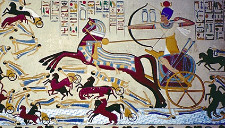 An image representing the Egyptian pharaoh
Ahmose I defeating the Hyksos in battle.
Bourriau's evidence militates against the traditional Egyptian view--as
espoused by Manetho--that the Hyksos invaded and sacked the Memphite
region and imposed their authority there. Not until the beginning of the
Theban wars of liberation during the 17th Dynasty are Theban wares found in
the Fayum-Memphis region which indicates that the Hyksos controlled the Delta
region while Middle Egypt and the Thebaid functioned autonomously and shared
limited contact with each other.
An image representing the Egyptian pharaoh
Ahmose I defeating the Hyksos in battle.
Bourriau's evidence militates against the traditional Egyptian view--as
espoused by Manetho--that the Hyksos invaded and sacked the Memphite
region and imposed their authority there. Not until the beginning of the
Theban wars of liberation during the 17th Dynasty are Theban wares found in
the Fayum-Memphis region which indicates that the Hyksos controlled the Delta
region while Middle Egypt and the Thebaid functioned autonomously and shared
limited contact with each other.
Kamose's reason for launching his attack on the
Hyksos was nationalistic pride, for in this same text he complains that he is sandwiched at Thebes
between the Asiatics in the north and the Nubians in the south, each holding
"his slice of Egypt, dividing up the land with me… My wish is to save Egypt
and to smite the Asiatics!" Hence, it was native Egyptian nationalism that
prompted Kamose to embark and sailed north from Thebes at the head
of his army in his third regional year.
He surprised and overran the southernmost garrison of the Hyksos at Nefrusy,
just north of Cusae [near modern Asyut], and Kamose then led his army as far north
as the neighborhood of Avaris itself. Though the city was not taken, the fields around
it were devastated by the Thebans. A second stele discovered at Thebes continues
the account of the war broken off on the Carnarvon Tablet I, and mentions the
interception and capture of a courier bearing a message from the Hyksos king
Aawoserra Apophis at Avaris to his ally the ruler of Kush (modern Sudan),
requesting the latter's urgent support against the threat posed by Kamose's
activities against both their kingdoms. Kamose promptly ordered a detachment
of his troops to occupy the Bahriya Oasis in the Western Desert to control
and block the desert route to the south. Kamose, called "the Strong", then
sailed back up the Nile to Thebes for a joyous victory celebration after what
was probably not much more than a surprise spoiling raid in force which caught
the Hyksos off guard. His Year 3 is the only date attested for Kamose.
Prof. Heard - who only focuses on the Ahmose stelle; “We have this very
interesting stele which is dated to the reign of Ahmose, [which]
records a tremendous catastrophe that happened to Egypt. We’re not quite clear what
it was, but it involved rain and thunder and lightning and such a storm that rarely
happens in northeast Africa... a dry area. It [seem]s peculiar to me that the
Biblical tradition preserves the memory of plagues, you know, which involve
climatic cataclysms and here we have from the very time this curious stele.”
Prof. Heard; says the Tempest Stelais locked up in the Cario museum and never seen
by the public. The stele tells of a prolonged flooding of Egypt, leading author Ralph Ellis to
equate this storm with the Hebrew Bible's tale of plagues in Exodus.The Tempest Stela (I will call it this in
preference to “Ahmose Stela,” since another stela of Ahmose is known) is a relatively
little-known artifact, and not all that much has been published about it. The American
Theological Library Association database lists only one journal article about it: REALLY? see
Tempest Stela
Thus, if the Tempest Stela can be connected to the ten
plagues, the plagues would have happened sometime in the period 1550–1525 BCE,
with a good case being made for 1550 itself.
Prof. Heard;"There are indeed some meteorological phenomena in the ten plagues:
in particular, the fourth and seventh plague consists of hail, lightning, thunder, and rain,
and the ninth plague, darkness, may have been meteorological. There is no mention
on the Tempest Stela of swarms of frogs (second plague), gnats (or mosquitoes,
third plague), flies (fourth plague), or locusts (eighth plague). Ahmose’s PR agent
(a.k.a. the stela’s author) says nothing about any diseases on livestock (fifth plague)
or humans (sixth plague). There are indeed corpses floating around on the Tempest Stela."
Jacobovici; "The hail, consisting of fire and ice, that is described by the Ipuwer papyrus,
is a phenomenon that vulconologists describe as acretionary lipilli or volcanic hail.
The volcanic ash and pumas, which are necessary to attribute this hail to the explosion
of the Santorini volcano has been found where it would have occurred."
Prof. Heard; A critical question for Jacobovici’s case is whether or not the description
of the calamity in the Temple Stela really resembles the biblical description of the ten plagues.
Here’s the description of the calamity from the Temple Stela, as translated by Allen
(lines 6–10 on the face of the stela, 8–12 on the reverse):
[Then] the gods [made] the sky come in a storm of r[ain, with dark]ness in
the western region and the sky beclouded without [stop, loud]er than [the sound of]
the subjects, strong[er than …, howling(?)] on the hills more than the sound of the
cavern in Elephantine. Then every house and every habitation they reached
[perished and those in them died, their corpses] floating on the water like skiffs
of papyrus, (even) in the doorway and the private apartments (of the palace),
for a period of up to […] days, while no torch could give light over the Two Lands.
Jacobovici; "Professor Heard does admit, implicitly, that the order of events that are
mentioned by this stela: the storm, the plague and the appearance of bodies
(occurring everywhere according to Allen’s translation of the stela–even within
the private apartments of the palace) occur in the same order as in the Exodus
account. The above document parallels a more detailed account of this period
(the beginning of the 18th Dynasty) in the Ipuwer papyrus, which describes rivers
as turning blood red, and hail consisting of fire and ice, prolonged darkness and
massive death (again the order of events is the same as in the Exodus account).
The El Arish stela, which also describes this period, also describes prolonged
darkness and divided waters."
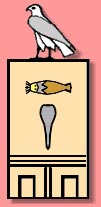 Both Professor Heard and Jacobovici are overlooking
one critical detail. The bible portrays Joseph as a hero and 'son of God', but in truth
he is a Seth worshiper as is his father and brothers. Seth is the same as Baal, Enlil,Yehwah,
ect. ie. mean and cruel! Joseph and his brothers are responsible for the death of
Seqenenre Tao and the loss of the secret word or name of the unknown, unnamed God.
Remember Israel means 'deceiver'. A trained Egyptian priest, Moses takes over
and tries to convert Seth followers to Horus followers. He does not succeed
and the evil God Enlil/Baal takes over the nation of Israel.
Both Professor Heard and Jacobovici are overlooking
one critical detail. The bible portrays Joseph as a hero and 'son of God', but in truth
he is a Seth worshiper as is his father and brothers. Seth is the same as Baal, Enlil,Yehwah,
ect. ie. mean and cruel! Joseph and his brothers are responsible for the death of
Seqenenre Tao and the loss of the secret word or name of the unknown, unnamed God.
Remember Israel means 'deceiver'. A trained Egyptian priest, Moses takes over
and tries to convert Seth followers to Horus followers. He does not succeed
and the evil God Enlil/Baal takes over the nation of Israel.
Remember Enlil is the God
of 'Material' possessions and this includes the Earth and the people on it.
Was Jacob a pharoah?"...We are therefore into the realm of the original covenant
of kingship made with Isaac. His son Esau may have sold his birthright to his younger
brother Jacob-Israel (whose descendants became kings of Judah), but now we discover that,
through Tuya and Yuya, descendants of Esau did indeed become pharaohs of Egypt.
These particular pharaohs have become known as the 'Amarna Kings': they are Akhenaten,
Smenkhkare, Tutankhamun and Aye, who ruled consecutively c.1367-1348 BC.
They are all serving Horus not the evil Seth. Our first Widow's Son page describes Seth
and the war of words the Hyksos pharoah was having with Seqenenre Tao in the 16th dynasty
of Egypt.
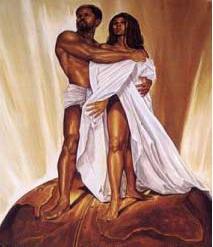 Where These Pharaohs Also the famous Biblical Patriarchs? The founder of this theory
is Ahmed Osman. He was soon followed by Ralph Ellis. They have devised charts and altered
time lines and chronologies to establish that Bible and Pharaonic king lists coincide. Ralph Ellis
believes that Jesus represented the last recorded Pharaoh of this line (Jesus, Last of the Pharaohs)
After the succession of Isaac, the emphasis in the Biblical narrative changes from
one of covenant and promises to that of birthright and favor. With each new generation,
favor is extended to a younger brother over the rights of one or more elder brothers.
First Esau and Jacob, then followed by Joseph and his elder half-brothers, and finally
Manasseh and Ephraim. Birth right and favor held paramount importance. It symbolized
kingly succession. Had Abraham, Isaac, Jacob and Joseph been merely migratory herdsmen
without an established kingdom, then a birthright would have been of little significance. Isaac was
actually the son of the Pharaoh and the source of the original connection between Egypt and Israel.
Where These Pharaohs Also the famous Biblical Patriarchs? The founder of this theory
is Ahmed Osman. He was soon followed by Ralph Ellis. They have devised charts and altered
time lines and chronologies to establish that Bible and Pharaonic king lists coincide. Ralph Ellis
believes that Jesus represented the last recorded Pharaoh of this line (Jesus, Last of the Pharaohs)
After the succession of Isaac, the emphasis in the Biblical narrative changes from
one of covenant and promises to that of birthright and favor. With each new generation,
favor is extended to a younger brother over the rights of one or more elder brothers.
First Esau and Jacob, then followed by Joseph and his elder half-brothers, and finally
Manasseh and Ephraim. Birth right and favor held paramount importance. It symbolized
kingly succession. Had Abraham, Isaac, Jacob and Joseph been merely migratory herdsmen
without an established kingdom, then a birthright would have been of little significance. Isaac was
actually the son of the Pharaoh and the source of the original connection between Egypt and Israel.
Professor Heard's version is therefore very unlikely. He bases
his opinion solely on the biblical version which has proven to be very unreliable since it
carries only one side of the story. And we cannot ignore what the stella says. One group
called their leader 'Pharoah' and the other, the true Egyptians - 'King'. The word 'king' was
associated with secret knowledge or a secret ceremony in which the king went to the after-life.
The ritual involved pronouncing the names of the 'guardians' who stood in the path of his
journey. This also included the secret name of the God which the king was to meet at his
final destination. The Hyksos pharoahs did not have this information.
Jacob and many of his family and followers settled in the district of Goshen in northeast
Egypt. Jacob himself built his home at Avaris. Some 17 years later, Jacob died and Joseph
then had a palace constructed on top of the foundations of his father's former residence.
Joseph went on to serve 10 Pharaohs. Indeed, at one time he was the sole ruler of
upper Egypt for six years (1625-1619 BC ?) until a new Pharaoh could be chosen.
In line with the rule of Ahmose the dating shows the time of the Exodus was 1550 - 1540 BC.
Ahmose wrote several letters confirming his success of the expulsion of the Shepherd People
and dedicating the success to his mother, Seqenenre's widow. After years of debate we
find the date of this expulsion coinsides with the volcanic eruption of the
Santorini Volcano on the island
of Thera. The previously set date of the Exodus was the conclusion of biblical theorists
who have no archeological or historical investigative experience.
The late exodus date is usually placed in the middle 15th century around 1440 BC, while
the early date is usually assigned to the close of the 13th century around 1290 BC. Both are wrong.
1 Kings 6:1: This verse gives a time period of 480 years between the exodus and
the beginning of Solomon’s work on the Jerusalem temple. From John Bright’s chronology,
Solomon ascended the throne around 961 BC, which would make the fourth year of his
reign and the beginning of temple construction about 959-957 BC (see Israelite Kings).
If we assume that the number 480 is to be taken as a precise number of years much as
we would count years on a calendar today, working backward from this date we arrive
at a date around 1440 BC for the exodus. This is the primary origin of the 1440 BC date
for the exodus....but this date has now proven to be incorrect.
Another web site posts; During the Middle Kingdom, Qantir became the summer
palace of the pharaohs of the Twelfth and Thirteenth Dynasties. In the Hyskos period, this same
area was the summer capital of the Hyksos kings. After their expulsion in the sixteenth
century BC, the early Eighteenth Dynasty pharaohs re-occupied the site. As Qantir has
been inhabited, at least since the time of the Hyksos kings, it seems improbable that
slaves of the Ramesside period could have been responsible for Qantir's construction.
A further illustration that Exod 1.11 does not require a thirteenth century date.
We reference Egyptologist Dr. Kelley L. Ross and his
Seventeenth Dynasty page.
( see the tables in the lower left of the page.) Seqenenre Tao II is placed in the XVII
dynasty of Thebes (1558 - 1554 BC) which directly corresponds with Apepi II (Archlês)
of Avaris, (Heliopolis) 1581-1541 BC in the XV dynasty of Hyksos rule.
Seqenenre Tao was the last true Egyptian king to know the secret name of God.
Jacob and his sons were part of this history- they lived at Avaris. Ramses was only
5 years old at the time so he wasn't the King at the time of the Exodus.
Going back 3000 years
The sons of Cush
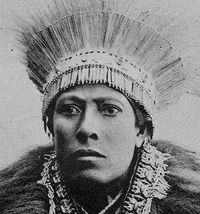 In Sumeria there was a land called Cush (Kush) obviously named after Noah's son Cush.
A Land called Canaan after Ham's fourth son was situated south and east of Cush as far as Gaza.
Genesis 10:19. Johann Michaelis and Rosenmuller have proposed that the name Cush was
applied to tracts of country on both sides of the Red Sea in the Arabia (Yemen) and in
Africa. The African Kush covered Northern Sudan, Upper Egypt, and extended southwards
from the First Cataract. In addition, the Cushitic peoples who live around the Horn of Africa
and today comprise the (1) Somali tribe.
In Sumeria there was a land called Cush (Kush) obviously named after Noah's son Cush.
A Land called Canaan after Ham's fourth son was situated south and east of Cush as far as Gaza.
Genesis 10:19. Johann Michaelis and Rosenmuller have proposed that the name Cush was
applied to tracts of country on both sides of the Red Sea in the Arabia (Yemen) and in
Africa. The African Kush covered Northern Sudan, Upper Egypt, and extended southwards
from the First Cataract. In addition, the Cushitic peoples who live around the Horn of Africa
and today comprise the (1) Somali tribe.
The (2) Afar tribe..
Popular history gives some insight into the history in the two traditional divisions of the Afar.
Tradition indicates that the Asayahamara (The Red Ones) are descended from a group
originally invading from the Ethiopian Highlands at one time, who imposed their rule on
the Adoyahmara (The White Ones). They are a dark brown with Caucasian features.
They are likewise distantly related to the ancient Beja group of peoples, who are Southern
Cushites, and related in turn to the ancient Egyptian race. They call themselves Afar,
which means in their language "The Best" or "First."
The (3) Oromo tribe
and several other tribes, are traditionally the offspring of the Biblical Cush, now
commonly known as "Arabs". In the Sumerian texts the gods called them "The Black headed
peoples", but they did not have black skin or the features of a negro race as
evidenced by this photo.
That the curse of Ham cannot be applied to black people is easily shown from the
text itself. What is usually missed is the astonishing unfolding of world history that the
words of this oracle refer to. ....
see
The Curse of Ham
To interpret the oracle we will need to understand the logic of the Table of Nations
given in Genesis 10 which is the next chapter. Scholars have generally assumed that
this outline of racial origins is ignorant guesswork based on the geographical locations
of the peoples that surrounded Israel many centuries after Abraham.
In his Introduction to the Old Testament (Eerdmans, 1969), R.K.Harrison boldly
claimed that "the Table of Nations is unquestionably of ancient origin" (p.559).
He argued that the source of Genesis 10:2-11:10a is a typical cuneiform tablet,
probably belonging to Shem's own family history, "written either from personal
knowledge or from other reliable sources" (p.548). He also points out that the
biblical interest in exactly kept genealogies is not unique. "The excavations at
Mari have shown the extent to which genealogical tables were treasured in antiquity
as a means of establishing pedigree" (p. 547).
According to Genesis 10 the known world was populated after the flood by races
descended from the three sons of Noah. Since the Medes (Madai) and Greeks
(Javan) are clearly identified, Genesis 10:2-5 obviously refers to the Indo-European
nations. Scholars have shown that the Nordic and Germanic tribes of Europe, the
Romans and Greeks, the early Iranians of Persia, and the Aryan tribes that invaded
India about 1800 B.C. spoke a group of languages so closely related in both grammar
and vocabulary that they must come from a common original. So let us try out the
biblical nomenclature and call these languages "Japhethite."
Next we have a Hamitic group of nations (Gen. 10:6-20). Ham had four sons named
Cush, Egypt (Mizraim), Put and Canaan. the eldest son, Cush, had a son called Nimrod,
who established "Babel, Erech, and Accad, all of them in the land of Shinar." Now the
difficulty is that the people of this area spoke Akkadian, which was unfortunately called
a Semitic language, as were Hebrew and Arabic.
Beginning with A.L.Schlozer (1781) scholars assumed that since Abraham
was a Shemite, and he spoke Hebrew, Hebrew should be called a Semitic language.
Then Arabic, Akkadian, Phoenician, Canaanite, and Moabite were also found to be of
this group, so they too were called Semitic languages.
This error of terminology makes it impossible to make sense of the many biblical
references to Canaanites, children of Ham, and children of Shem. To use the biblical
terminology we should distinguish between Abraham's race or genealogy, which was
Shemitic, and his spoken language, Hebrew, which was "the language of Canaan"
(Isaiah 19:18). In a moment I will argue that Abraham's ancestral language was
Sumerian, that he spoke Akkadian before leaving Ur, and so found it easy to understand
Canaanite, another Hamitic (wrongly called Semitic) tongue as he moved into the
western part of the Fertile Crescent.
Now if scholars had taken the Table of Nations seriously, they would have looked
for four closely related groups of Hamitic languages. There were the sons of Cush, who spoke
Akkadian, the sons of Mizraim, who spoke Egyptian, the sons of Put, who spoke various
North African dialects, and the sons of Canaan, who spoke Canaanite and Phoenician.
The Table of Nations also suggests that the Casluhim were the ancestors of
the Philistines and Minoans (Caphtorim) of Crete (see Deuteronomy 2:23, Jeremiah
47:4, Amos 9:7), and all these people were descended by genealogy from an Egyptian
ancestry (Mizraim).
Having despised the biblical terminology, scholars had to put in many years of
painstaking work to discover that the Akkadian language of of Babylon was related to
Canaaanite and Phoenician (usually called West Semitic instead of Hamitic). Then it
was found that Egyptian had structural similarity to both Canaanite and various African
languages like Galla, Somali, and Berber (Alan Gardiner, Egyptian Grammar, 1950, p.2).
The first sentence in the curse of Ham tells us that the descendants of Canaan
were to be enslaved by brother Hamites. "Cursed be Canaan; a slave of slaves shall he
be to his brothers." This in fact kept happening over a period of a thousand years. By
the fifteenth century B.C. Canaanite states were under the domination of Egypt. From
841 B.C. for the next two centuries the Canaanites of Phoenicia were repeatedly
enslaved by Akkadian kings from the area of Assyria. Later, as prophesied by both
Jeremiah and Ezekiel, the Phoenicians came under the Akkadians from Babylonia.
Secondly, in our text we are told that the Canaanites were to be enslaved
by the desendants of Shem. "Blessed by the LORD my God be Shem; and let Canaan
be his slave." This was fulfilled when Abraham's descendants, who had kept their
Shemitic genealogical identity (though they spoke a Hamitic dialect), multiplied in
Egypt and came back to defeat Og and Sihon, Amorite kings of Transjordan, and
then overcame the Canaanite tribes west of the Jordan under Joshua.
In the third part of Noah's prophecy it is stated that the Canaanites were
later to be enslaved by Japhethites, or Indo-Europeans. "God enlarge Japheth, and
let him dwell in the tents of Shem; and let Canaan be his slave." This took place
when the people of Tyre and Sidon, who were the only Canaanites who still retained
a national identity, were subjugated by Greeks under Alexander the Great. That
still left the expatriate Canaanites of the Phoenician colonies, who fought so
valiantly against the Japhethite Romans in the Punic wars. The destruction of
Carthage in 146 B.C. would then mark the completion of the curse of Ham on
the Canaanites who had ceased to be a nation by New Testament times.
Whatever we think of such an astonishing prophecy, it obviously has
nothing to do with the Black people of today. Whether the races of central Africa
were descended from Mizraim, or from Put, or from some other genealogical strain,
they are definitely not classed as Canaanites, who alone were under Noah's curse
of Ham.
Finally we note that in the third section of the prophecy Japhethites are
to be "enlarged," and they will occupy Shemitic territory. By about 1800 B.C.
invading Indo-Europeans had taken over Asia Minor and overthrown the ancient
Shemitic kingdom of Lydia. The great Hittite empire of Asia Minor (not to be
confused with the Canaanite Khitti of Genesis 15:20, Exodus 3:8, 13:15, etc.)
was Indo-European, and it ruled over large areas of what had been Shemitic
territory. Later the Japhethite Medes and Persians occupied the territory of
the Shemitic Elamites.
The Oromo are an indigenous African ethnic group found in Ethiopia and to a lesser extent
in Kenya and (Genetics) -Somalia.
They are the largest single ethnic group in Ethiopia, at 32.1% of the population according to the
1994 census, and today numbering around 25 million. Their native language is the Oromo, Genesis
also suggests that the Biblical term was also applied to parts of Arabia. This territory included
Sodom and Gomorrah.
The eponym 'Ham' merely means "Hot" or "Red" (not black) in Hebrew or Canaanite.
Some authors reason that the attribution was made because the Canaanite coast but not the
interior was under Egyptian domination for several centuries. References to Canaanites are also
found throughout the Amarna letters of Pharaoh Akenaton circa 1350 BC, and a reference to the
"land of Canaan" is found on the statue of Idrimi of Alalakh in modern Syria. Canaanite confederacies
were centred on Megiddo and Kadesh, before again being brought into the Egyptian Empire.
see Canaan
According to the bible Noah was 500 years old when he became a father and it
describes Ham as being the youngest son. Genesis 10:24. Ham moved to Egypt as the
nations and their peoples multiplied. His son Mizraim is an early epilet (name) for Egypt.
Archaeological digs give us a recorded history back to the time of
Adam and up until the Exodus. This is important because it sheds a whole new light on our
ancient brothers mentioned in the Hebrew Torah from whence our modern bible came.
Most people focus on what happened after the great flood, but in order to find the truth
we must investigate what took place before the flood.
Matthew 13:35, "I will utter things
which have been kept secret from the foundation of the world."
The Hebrew people first emerged from Sumeria or the Middle East around Turkey,
with Noah and his sons. The biblical estimation of this time period goes all the way back to the
Bronze age (4th millennium BC.),
but there are claims of an earlier appearance of tin and bronze in Thailand in the 5th millennium BC.
Metallurgy developed first in Anatolia, modern Turkey. The mountains in the Anatolian highland
possessed rich deposits of copper and tin. Copper was also mined in Cyprus, the Negev desert,
Iran and around the Persian Gulf. Most amazing of all is the discovery of a gold mine
in South Africa dated to 100,000 BC. Oddly enough there is this in Genesis 2:11,12;
"The name of the first river to water crops is Pishon, where there is gold."
"The gold of that land is good;.."The land was called "Cush".
And in Genesis 2:5 we find this..
"There was no man to work the ground."
This statement is significant as we will later discover.
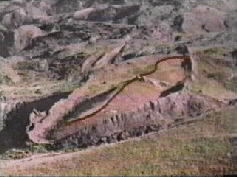
 An explorer who claims to have found Noah's Ark also found iron bolts embeded in the
gopher wood at the site in Turkey. This is the site. The rest of the artifacts which
include large stones with holes in them suitable for rope which was attached to them as anchors
of a large ship are on our page entitled 'Passage of Secrets 6'. One stone even has Nimrod's
name carved into it and the sign of the cross which looks exactly like a 'Templar Cross'.
An explorer who claims to have found Noah's Ark also found iron bolts embeded in the
gopher wood at the site in Turkey. This is the site. The rest of the artifacts which
include large stones with holes in them suitable for rope which was attached to them as anchors
of a large ship are on our page entitled 'Passage of Secrets 6'. One stone even has Nimrod's
name carved into it and the sign of the cross which looks exactly like a 'Templar Cross'.
If we consider that Adam, Enoch, Moses, King David, King Solomon, and Jesus all got taged as false
teachers or sinners we might begin to understand why if we look into the very ancient past with an
open mind. A 'hint' to the real secret begins with Abraham declaring there was only 'One God'.
This God told Abraham's father Terah to leave his country which at the time was in Mesopotamia,
specifically UR. Genesis 11:31. They went to Canaan, ie. Shechem which at the time was part of Egypt.
Abraham called his God, "The God of my fathers". He called on the name of the "Lord" in Genesis 12:8,
but does not mention his name. In the time of Noah HE is simply refered to as "God" but also refered
to as "The Lord" when he wipes mankind off the face of the Earth in Genesis 6.
Akhenten made the same decision about the Sun God Aten in Egypt AFTER the expulsion of the
Jews.
We continue to have an explaination concerning the possibility that there are
two different Gods
How did this come about? The information below about 'other ancient texts', Adam, Noah,
Nimrod, the city of Nineveh and the real story about the sons of Noah reveals a different story that what
we've been taught as children in Sunday school.. This information obviously is not found in the bible.
These facts we are about to present are recorded in six ancient texts beginning with
the Secret Books of Enoch when he speeks about The Watchers. Then we have the Epic
of Gilgamesh, the Nag Hammidi scrolls (concerning Noah in the
The Apocalypse of Adam ).
This text mentions a God named Sacla or Sakla and calls him "Their God".. Another conformation is
recorded in the 5000 year old Enuma Elish clay tablets, in the Epic of Creation
with Gods called Anu, Enki and Enlil and several others. The notion that there were several
gods (actually 114) also appeared in the Egyptian texts over and over.
The Egyptians worshipped gods that were beautiful to behold, luminous beings that walked
the earth, guiding the human race to Paradise. They had human forms but were much
more powerful; yet like humans, they got angry, despaired, fought with one another,
had children, and fell in love. They lived lives that were very much like those of the
people who worshipped them.
In the newly published Gospel of Judas,
(National Geographic cable channel) we find Jesus
refering to "Your God!". That means the Gods of Summer were not mythological gods as the
church would have you believe and there isn't just ONE. Since the original version
of the Creation texts are written in allegory, (the same way Jesus taught) there are many
translations. ( allegory is a figurative mode of representation conveying a meaning other than
the literal) An analogy appeals to reason or logic.
Simplicity: The Sun and Moon, for instance, are referred to simply as the "greater and
lesser lights" (Genesis 1:16). It is well known that astronomy is one of the most ancient
branches of knowledge. In earliest times the Babylonians had already given names to
the Sun and Moon and the planets.
Brevity: Compared with the lengthy Babylonian series of six tablets of creation, the Bible
uses only one fortieth the number of words. The most important text is this 50,000
year old list of Ante-diluvian kings,
from the city of Eridu, dubed legendary, which appear earlier than ca. the 26th century BC.
We also have works called Apocrypha which
were not included in the offical 'cannon' of the bible. It is a large list.
and see
Apocrypha list
The word "apocryphal" was first applied, in a positive sense, to writings which were kept
secret because they were the vehicles of esoteric knowledge considered too profound or
too sacred to be disclosed to anyone other than the initiated. It is used in this sense to describe
A Holy and Secret Book of Moses, called Eighth, or Holy, a text taken from a Leiden papyrus
of the third or fourth century AD, but which may be as old as the first century. In a similar
vein, the disciples of the Gnostic Prodicus boasted that they possessed the secret books of
Zoroaster. The term in general enjoyed high consideration among the Gnostics
(see Acts of Thomas, 10, 27, 44)
Doctrines of Genesis Brought to Court
Jean Astruc, Louis XV's doctor, that we owe the decisive argument because
he placed the accent on the plurality of sources. He was probably not the first
to have noticed it, but he did however have the courage to make public an
observation of prime importance: two texts, each denoted by the way in
which God was named either Yahweh or Elohim, were present side by
side in Genesis. The latter therefore contained two juxtaposed texts.
Eichorn (1780-1783) made the same discovery for the other four books;
then Ilgen (1798) noticed that one of the texts isolated by Astruc, the
one where God is named Elohim, was itself divided into two.
The Pentateuch literally fell apart.
The Nineteenth century saw an even more minute search into
the sources. In 1854, four sources were recognised. They were called
the Yahvist version, the Elohist version, Deuteronomy, and the Sacerdotal
version. It was even possible to date them:
1) The Yahvist version was placed in the Ninth century B.C. (written in Judah)
2) The Elohist version was probably a little more recent (written in Israel)
3) Deuteronomy was from the Eighth century B.C. for some (E. Jacob) , and
from the time of Josuha for others (Father de Vaux)
4) The Sacerdotal version came from the period of exile or after the exile:
Sixth century B.C.
It can be seen that the arrangement of the text of the Pentateuch spans
at least three centuries.
Each of these areas is now the object of intense litigation across the USA and
other western nations. Why? Ideas have consequences; and when true ideas are rejected,
negative consequences will arise. The Apostle Paul, when commenting on Genesis in Romans
1, indicated that a great exchange occurred after the Fall: the Truth exchanged for, literally,
the Lie. The context of Romans 1 makes plain that the manifestations of this exchange will
center on two areas:
(1) issues dealing with suppressing the Creator's existence; and
(2) issues reflecting a rejection of creational norms regulating sexual activity.
The Leiden papyrus
Remarkably, this ancient papyrus parallels the history of the Exodus account as found
in the Scriptures. This manuscript recorded the writings of an ancient Egyptian named Ipuwer.
The papyrus manuscript, now called the Ipuwer Papyrus, was discovered by someone named
Anastasi in the area of Memphis, near the pyramids of Saqqara in Egypt.
The museum of Leiden in the Netherlands acquired the papyrus in 1828. It was
translated and published in English for the first time in 1909 by Professor Alan H. Gardiner.
Gardiner wrote that the manuscript was one that recorded a genuine historical
catastrophe when the whole country of Egypt was in distress and violence. "It is
no merely local disturbance that is here described, but a great and overwhelming
national disaster." and see Leiden
To back this up - on the next 3 pages we cover the catastrophe in archeological
terms and explain what really happened. Moses, using Gods power - could control nature!
Magic was from the earliest times largely developed by the Egyptians in relation both
to the dead and the living. Under the former head fall both the pyramid texts and other
texts found in the tombs, including most of the Book of the Dead, which consists mainly
of magical invocations intended to make smooth the path of the deceased in the next world.
see Magical incantations. Note;
These incantaions have been called 'demonic' however in all the secret writings we found about Enoch,
Moses and King Solomon are evidence that they used magic. The Egyptian Book of the Dead also states
that knowing the names of the Gods is how they controlled them. Each God had several names
and this is confirmed also in the Nag Hammidi scrolls. Also note that you will see the names
of Osiris, Isis, Horus, Ra, Ptah, Maat, Thoth, and the city of Thebes (Memphis). Moses grew up in
Thebes.
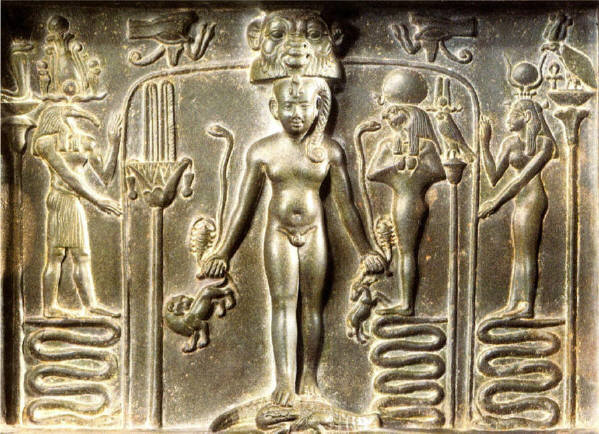 Magical texts for the use of the living are found in the Harris magical papyrus
(ed. Chabas, 1860), the Metternich stela
(ed. Golenischeff, 1877) and kindred stones,
the Berlin papyrus edited by Erman (Zaubersprüche für Mutter u. Kind, 1901), &c.
Reference may be made to the volume on Egyptian magic by Dr. Wallis Budge, 1899,
and to a special study on vessel-divination by E. Lefébure, 'Le vase divinatoire,' in Sphinx,
1902, VI. 61 seq. Cf. also Dieterich, 'Abraxas'; Kenyon in Cat. Greek Pap. in B. M., I. 62 seq.;
Miss Macdonald in P. S. B. A., xiii. 160 seq.; Wünsch, Sethianische Verfluchungstafeln aus Rom, &c.
Magical texts for the use of the living are found in the Harris magical papyrus
(ed. Chabas, 1860), the Metternich stela
(ed. Golenischeff, 1877) and kindred stones,
the Berlin papyrus edited by Erman (Zaubersprüche für Mutter u. Kind, 1901), &c.
Reference may be made to the volume on Egyptian magic by Dr. Wallis Budge, 1899,
and to a special study on vessel-divination by E. Lefébure, 'Le vase divinatoire,' in Sphinx,
1902, VI. 61 seq. Cf. also Dieterich, 'Abraxas'; Kenyon in Cat. Greek Pap. in B. M., I. 62 seq.;
Miss Macdonald in P. S. B. A., xiii. 160 seq.; Wünsch, Sethianische Verfluchungstafeln aus Rom, &c.
In the closely allied department of medicine, it is sufficient to refer to the Ebers papyrus, the
Kahun papyri, and the Berlin medical
papyrus (ed. Brugsch, Rec. Mon. pl. 87-107), which offer
many parallels. Among the Greek medical writers it is noticeable that Alexander of Tralles
seems much more closely allied to the Egyptian school, if that be represented by our MS., than Galen.
Plato also figures into this ancient history when he wrote about an advanced society that lived on
a now sunken island that lay between the United States and Europe nearly 11,000 years ago.
The Bermuda Triangle shows evidence of a magnetic interference with compasses and electronic
equipment. This may be the proof we have been looking for that Atlantis and an advanced society
did infact exist..
We also have evidence of a catastrophic event that included the melting of the polar ice caps,
volcanoes, earthquakes, and the shifting of the Earth's surface which comes into play at the same time.
Scientists revealed that a map of Antartica was found that showed evidence of a tropical climate
some 12,000 years ago. This map is on our Atlantis pages.
The Bible tells us that the first humans - Adam and Eve were created by God but a strange
word appears in the Torah as well as the Bible. The word is US!...plural! ..more
than one. The Bible and the Torah reveal the word right there in Genesis, beginning with
Genesis 1:26 and 3:22.
Josephus also gives us clues in his story about Nimrod.
And we see the word 'OUR' in other verses, like 'OUR image, and 'OUR likness' in the story
of Adam and Eve. And in the Story about Nimrod in Genesis 11:7 we see it again,
"Come let US go down and confuse their language, so that they would
not understand each other." WHO IS "US"?
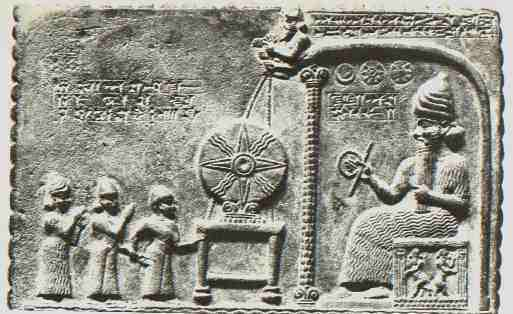 After Adam and Eve, thousands of years passed before 'God' became angry in Genesis 6 when
'HIS' sons went to the daughters of men and had children by them. These children are called the
Nephilim and are also described as "heroes of old, men of renown.' A clear contridiction since
they are also called evil and they taught man so-called forbidden skills.
After Adam and Eve, thousands of years passed before 'God' became angry in Genesis 6 when
'HIS' sons went to the daughters of men and had children by them. These children are called the
Nephilim and are also described as "heroes of old, men of renown.' A clear contridiction since
they are also called evil and they taught man so-called forbidden skills.
Bible verses prove it; "...And moreover we saw the descendants of Anak there...a land that
devours its inhabitants; and all the people whom we saw in it are men of great size. There also we saw
the Nephilim; and we became like grasshoppers in our own sight, and so we were in their sight."
Numbers 13:28-33 The name Anakim means literally "long necked" and are first mentioned in
Deuteronomy 1:28, a race of giants (Deuteronomy 2:10-11). Biblical theorists dismiss this as myth.
There's proof it isn't..
Giants
"The hard part is not finding the truth. The hard part is accepting it,
especially when it means that your presently held views are proven wrong."
According to ancient literature, humans and giants were rarely able to live together in
harmony. A manuscript called The Apocalypse of Baruch, a pseudepigraphical work written
around AD 100 and preserved only in the sixth-century Syriac Vulgate (and which seems a little
unclear in parts) appears to hint at the origin of giants: "Men began as giants. These first
giants were very highly developed, intellectually, artistically and physically - they had
power over birds and animals...they misbehaved and were abolished by God, and ordinary
men took their place..". "On the earth there once were giants," Greek poet Homer
wrote in 400 B.C.
Cain and Abel
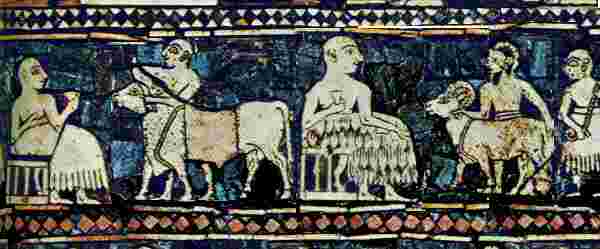 The Jewish New Year is now 5768. In the Sumerian Epic of Creation texts,
the beginning of the count was after the God Anu's visit to Region 1: Unug-ki (UR).
This occured around 10,000 BC. These gods have been described as evil and mythical by
church followers but apparently they interacted with Adam and Eve, Cain and Abel and Noah and his sons.
This graphic shows two Gods (seated) and it seems that Cain and Abel are shown also.
Adam may also be in this picture as the 3rd man (middle/taller) and is presenting a cow to the
God who is seated. Take note that Abel has a beard, Cain does not. Abel is presenting livestock
to the Gods, Cain is presenting grain. The 'men' are of smaller stature than the 'Gods'.
The Jewish New Year is now 5768. In the Sumerian Epic of Creation texts,
the beginning of the count was after the God Anu's visit to Region 1: Unug-ki (UR).
This occured around 10,000 BC. These gods have been described as evil and mythical by
church followers but apparently they interacted with Adam and Eve, Cain and Abel and Noah and his sons.
This graphic shows two Gods (seated) and it seems that Cain and Abel are shown also.
Adam may also be in this picture as the 3rd man (middle/taller) and is presenting a cow to the
God who is seated. Take note that Abel has a beard, Cain does not. Abel is presenting livestock
to the Gods, Cain is presenting grain. The 'men' are of smaller stature than the 'Gods'.
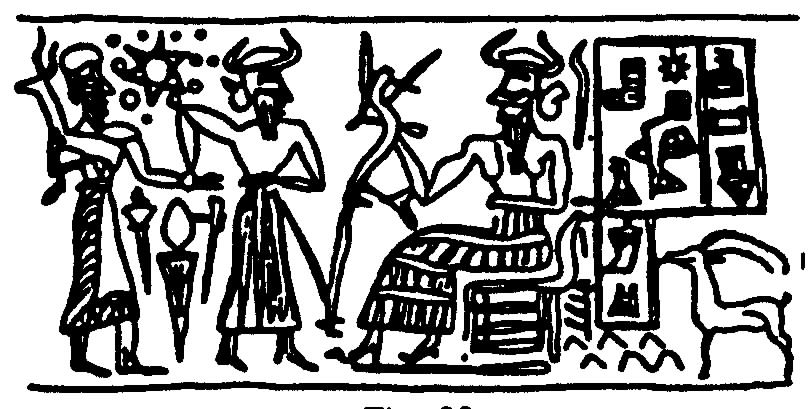
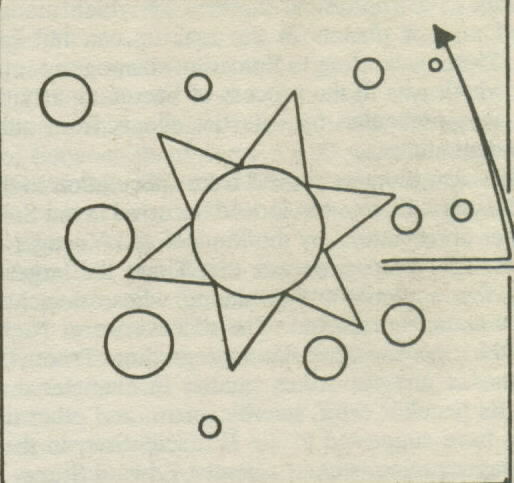 This cylinder seal called VA/243 is kept in the
Vorderasiatisches Museum
in Berlin. On it we see the God of farming granting the plough to mankind or Cain. It is dated
to 2500 BC. Cain appears on the far left. In the upper left between the god and Cain we see a
star shaped image with 11 smaller circles around it. The star is representative of the
Sun so it follows that there are 11 planets around the Sun = 12. The museum's director
sent Zacharia Sitchin a brief bibliography of published data. The research explains
that 4,500 years ago, thousands of years before the invention of the telescope -
A Sumerian artist depicted our complete solar system, with its star, the Sun - in the
center. The opinion of a noted astronomer was that, "but since there is no way
the Sumerians could have known that 6,000 years ago, it must be a depiction
of another solar system."
This cylinder seal called VA/243 is kept in the
Vorderasiatisches Museum
in Berlin. On it we see the God of farming granting the plough to mankind or Cain. It is dated
to 2500 BC. Cain appears on the far left. In the upper left between the god and Cain we see a
star shaped image with 11 smaller circles around it. The star is representative of the
Sun so it follows that there are 11 planets around the Sun = 12. The museum's director
sent Zacharia Sitchin a brief bibliography of published data. The research explains
that 4,500 years ago, thousands of years before the invention of the telescope -
A Sumerian artist depicted our complete solar system, with its star, the Sun - in the
center. The opinion of a noted astronomer was that, "but since there is no way
the Sumerians could have known that 6,000 years ago, it must be a depiction
of another solar system."
from Journeys to the Mystical Past -
Zecharia Sitchin. He says, of cource that's impossible too so what gives here?
In the myth of
'Emesh and Enten',
two minor gods, one of farming and one of shepherding,
fall into a quarrel. They finally bring their case to Nippur to be judged by Enlil who, in a decision
that contradicts that given by the God of Genesis, chooses the farmer over the shepherd.
In the myth of Cattle and Grain the siblings Lahar, a cattle god, and Ashnan, a grain goddess,
get into a quarrel over who deserves more recognition, but unfortunately the end of the myth
has not survived.
The myth 'Inanna Prefers the Farmer' is another variation on the Cain and Abel theme.
In this story Inanna rejects the advances of the shepherd who then becomes belligerent
towards Inanna's favorite, the farmer. Only after the farmer offers soothing words of
appeasement and a number of gifts in consolation, including that of Inanna herself,
does the shepherd's anger subside. In the Genesis account it is the farmer, Cain, who
kills Abel the shepherd in a jealous rage.
On our Forbidden Forward pages we have more of the Sumerian
drawings of the solar system which show 12 planets including the Sun. Our
count at present is 11 including the Sun - now minus Pluto which we note
travels in the opposite direction as the others. This cylinder shows a large planet
between Mars and Jupiter and at the time the Earth was larger than it is now.
We explain why on ForbiddenKnowledge.
Zecharia Sitchin - Authority on the ancient Sumerian texts says:
"Contrary to to the common assumption that the Jewish count
of years is from the beginning of the world, it is actually from the beginning of the
Nippurian calendar in 3760 BC - the time, we assume, of the God Anu's state visit to Earth." This
according to the texts, is when 'Kingship' was lowered from 'Heaven' by the Gods.
The 'priesthood' had already been given to Adam, Seth and Enoch as we see that Enoch
was taken to Heaven and taught all the secrets of the Gods. When he returned a city was
named after him - Ediru. This began a tradition that only priests were given sacred knowledge
and they could not share it, except with an eldest son - someone expected to take their place
after their death.
From the Sumerian texts; The entire Sumer area including (ED.IN) was the God Enlil's
(Anu's second born Son) lineage's domain: "Enlil and his lineage, decreed the King, rule Mesopotamia
through their designated kings, descendants of Ziasudra's (Noah) sons, Shem and Japhet the Fair.
Ziasudra's eldest son, Shem, and his descendents, rule the nations from the highlands running from
the Persian Gulf to the Mediterranean"... Around 7400 BC. Why is there no mention of Ham?
From the Hebrew Torah:
18 Vayihyu venei-Noach hayotze'im min-hatevah Shem veCham veYafet veCham hu avi Chena'an.
Translated; The sons of Noach, who went out of the ark where Shem, Yafet (Japhet), and
Cham (Ham); Cham was the father of Kenaan. verse 26 - He then said, "Blessed is HASHEM,
G-d of Shem; may Kenaan be his slave. In this instance the "Shem" means 'rocket'.
Zacharia Sitchin Divine Encounters p139.
Ham's son Canaan is cursed by Noah in Genesis 9:25 for no apparent reason. (Ham seeing hm
in his nakedness should have not evoked such a harsh responce.) It is possible that something else
took place that caused Noah to curse Canaan but it was deleted or changed for some unknown reason.
In Zacharia Sitchin's Divine Encounters, Ham 'unmans Noah'.
Christian interpretations of Ham changed a great deal over time:
“Augustine figured him as “the symbol of the man in isolation, the clanless, lawless,
hearthless man who, like heathen ethnics, did not know God.” ...[T]he medieval portrait
of Ham recalled earlier affirmations of his craftiness, prodigious sexuality, and affiliation
with magic and the Devil.
Noah's Curse: The Biblical Justification of American Slavery...For Luther, Ham’s laughter
at his father’s nakedness is a serious offense indicating that Ham “regard[s] himself as
more righteous, holier, and more pious than his father.”...Bible readers have blamed Ham
and his progeny for everything from the existence of slavery and serfdom, to the perpetuation
of sexual license and perversion, to the introduction of magical arts, astrology, idolatry,
witchcraft, and heathen religion. They have associated Hamites with tyranny, theft,
heresy, blasphemy, rebellion, war, and even deicide. Benjamin Braude’s observation
that during the Middle Ages Ham was “an archetypical Other, the example of qualities
not to be emulated,” could be fairly applied to the entire history of interpretation.”
This story has long functioned as a model for Christians to insist that God
meant for Africans to be marked as the servants of others because they are
descended from Ham. Somewhat secondarily they use the story of the Tower
of Babel as a model for God’s desire to separate people generally rather than
have them united in common cause and purpose.
Genesis 9:22-23 Uncovering the nakedness of a person can refer to sexual
intercourse (Leviticus 18:7-8, 20:11). So it is possible that Ham had sexual intercourse
with his mother while his father was drunk (for another case of incest see 19:30-3).
This would explain the enormity of what happened. When Ham gloatingly reported
to his brothers what he had done, they refused to look, and carefully covered the
nakedness of their father and/or their mother. However there is another meaning.
Genesis 9:24-27 We wondered why Noah’s grandson Canaan was cursed?
Maybe the cursing meant that because of being born as a result of the incest
Canaan was removed from his right to Ham’s family inheritance. As we will see in
the next chapter the line of Canaan became the Canaanites, and they were later
known as the Phoenicians (10:15-19). They are one of the very few nations
which has completely disappeared from history. For one interpretation of this
strange curse see "The Curse of Ham" (under Essays and Articles).
Anyway Canaan is reduced to being a 'slave' for his father's sin.
Part of the problem for poor Ham is that the biblical text is rather silent on what
exactly he did wrong. All it says is that the saw his father naked and told his brothers —
hardly a good reason to curse all of his descendants. That, however, is what the Bible
says the punishment was so it must be a fair and just punishment. Thus, readers have
sought ever since to find a just explanation — and the supposed descendants of Ham
have had to pay the price.
A few verses later, a son of Cush -
Nimrod is building great cities. By their design it is assumed that Nimrod was familar with Geometry.
But these were not the first cities because UR and Ediru on the Persian
Gulf already existed before the flood. How did Nimrod learn Geometry?
From the Torah; Genesis 10: Hu-hayah gibor-tza'id lifnei HASHEM al-ken ye'amar keNimrod gibor tza'id
lifnei HASHEM. Translation; He was a mighty hunter before HASHEM. It is therefore said,
"Like Nimrod, a mighty hunter before HASHEM."
This strange verse appears in the
Torah at Genesis 10:21. (2/3rds down.)
UleShem yulad gam-hu avi
kol-bnei-Ever achi Yefet hagadol. Translation; Sons were also born to Shem,
father of the Children of the Other Side. He was the brother of Yafet, the elder.
Does this suggest that the Shem, Japhet and their sons are not the same as Noah's son Ham
and his sons? The The Apocalypse of Adam
in the Nag Hammidi Scrolls confirms this might be true.
The Nun who lost her Faith
In the 20th century we see how Mother Terresa struggled all her life with her faith.
The devastation and starvation she witnessed was overwhelming, yet she was only able to help
them with her prayers and her love for these sick dying people which did little or no good at all.
Here is an excerpt from her Nobel Peace Prize acceptance speech;
"I choose the poverty of our poor people. But I am grateful to receive (the Nobel) in the name
of the hungry, the naked, the homeless, of the crippled, of the blind, of the lepers, of all those
people who feel unwanted, unloved, uncared-for throughout society, people that have become
a burden to the society and are shunned by everyone." She made millions of dollars, but never
divulged any figures to the public. A ton of donated money didn’t go to orphans in India or
anywhere else the contributors may have hoped — it went straight to the Vatican.
Masons and others who are bored or fed up with dogmatic teaching and who
search for this truth will find it. It lays in the 'Spiritual' not the 'Material' universe.
We will explore the 'material' secrets first. Our page on 'The light of your soul' and a
secret page reveals the 'spiritual'.
Some of the old secrets of the Masters involved the combining of metals to forge tools.
They also involved cutting stones in such a way as to have them perfectly straight and to be a percise
fit with the next one. When we consider Noah - how did he get the knowledge to
build the Ark? How did he know what 'pitch' was and how to make it? How did
Cain have the knowledge to build a city?
The Workman made this Universal
World, not with his Hands, but his Word. As many therefore as understood the
Proclamation, and were baptized or dowsed into the Mind, these were
made partakers of Knowledge, and became perfect men, receiving the Mind.
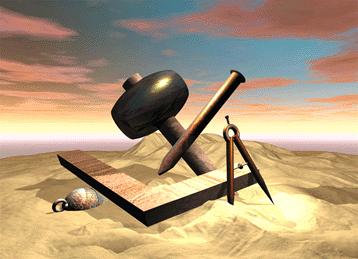 What first
comes to mind is that whatever they were building had to be 'measured'. We remember
that God gave explicit instructions to Noah about the dimensions of the 'boat' he was to build.
Here are the 'tools' to accomplish this feat.
What first
comes to mind is that whatever they were building had to be 'measured'. We remember
that God gave explicit instructions to Noah about the dimensions of the 'boat' he was to build.
Here are the 'tools' to accomplish this feat.
The hammer (stone maul), compass, square,
chisel, and plumb bob. The element to 'measure' was usually a cord or rope with knots in it at
the 'cubit' count. Genesis 6:14 has these requirements and measurements; Make a boat
from resinous (gopher) wood, sealing it with pitch or tar. Make it 450 feet long,
(three hundred cubits) 75 feet wide, (fifty cubits) and 45 ft high
(thirty Cubits). Construct a (in a cubit) window (it above), and make three decks inside the
boat - a bottom, middle and upper deck - and put a door in the side.
The copper bar cubit of Nippur defines the Sumerian cubit as 51.72 cm
Our Passage of Secrets page 2 reveals: 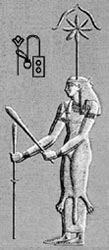 The stretching of cords to determine the proper astronomical orientation of a temple
was the task of a goddess called Sesheta in Egypt. She was on the one hand a Goddess of
the Calendar; her epithets were “the great one, lady of letters, mistress of the House of
Books” and her symbol was the stylus made of a palm branch, which in Egyptian hieroglyphs
stood for “counting the years.” She was depicted with a seven-rayed star within the Heavenly
Bow on her head. She was the Goddess of Construction, but only (as pointed out by Sir
Norman Lockyer in The Dawn of Astronomy) for the purpose of determining the orientation
of temples. Such an orientation was not haphazard or a matter left to guesswork. The
Egyptians relied on divine guidance to determine the orientation and major axis of
their temples; the task was assigned to Sesheta. Auguste Mariette, reporting on his
finds at Denderah
where depictions and inscriptions pertaining to
Sesheta were discovered,
said it was she who “made certain that the construction of sacred shrines was carried out
exactly according to the directions contained in the Divine Books.”
The stretching of cords to determine the proper astronomical orientation of a temple
was the task of a goddess called Sesheta in Egypt. She was on the one hand a Goddess of
the Calendar; her epithets were “the great one, lady of letters, mistress of the House of
Books” and her symbol was the stylus made of a palm branch, which in Egyptian hieroglyphs
stood for “counting the years.” She was depicted with a seven-rayed star within the Heavenly
Bow on her head. She was the Goddess of Construction, but only (as pointed out by Sir
Norman Lockyer in The Dawn of Astronomy) for the purpose of determining the orientation
of temples. Such an orientation was not haphazard or a matter left to guesswork. The
Egyptians relied on divine guidance to determine the orientation and major axis of
their temples; the task was assigned to Sesheta. Auguste Mariette, reporting on his
finds at Denderah
where depictions and inscriptions pertaining to
Sesheta were discovered,
said it was she who “made certain that the construction of sacred shrines was carried out
exactly according to the directions contained in the Divine Books.”
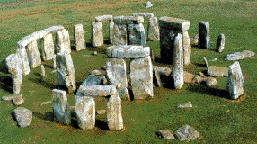 In mystic Britain white-robed Priests
planned Stonehenge. Stonehenge is a group
of standing stones on Salisbury Plain in southern England which date to c. 2000-1800 B.C.,
the megaliths are enclosed by a circular ditch and embankment that may date to c.
2800. The arrangement of the stones suggests that Stonehenge was used as a religious
center and also as an astronomical observatory. There are 56 Aubrey holes.
In mystic Britain white-robed Priests
planned Stonehenge. Stonehenge is a group
of standing stones on Salisbury Plain in southern England which date to c. 2000-1800 B.C.,
the megaliths are enclosed by a circular ditch and embankment that may date to c.
2800. The arrangement of the stones suggests that Stonehenge was used as a religious
center and also as an astronomical observatory. There are 56 Aubrey holes.
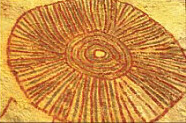 The month was defined as the period from
one new moon to the next, and this time period is 27 or 28 days. The path of the moon
in the sky was thus divided into 27 or 28 parts, and each part was named after a
prominent star in it. For the exact counting 27 mansions of the moon
would not do. The system counting nights is maybe the oldest invention and the Indians
made it a system with 28 mansions and the 28 at asterism. Vega was used for intercalation.
It is shown that in the Lascaux cave the motif with 28 dots could be compared to the Indian
system of naksatras = mansions of the moon.
The month was defined as the period from
one new moon to the next, and this time period is 27 or 28 days. The path of the moon
in the sky was thus divided into 27 or 28 parts, and each part was named after a
prominent star in it. For the exact counting 27 mansions of the moon
would not do. The system counting nights is maybe the oldest invention and the Indians
made it a system with 28 mansions and the 28 at asterism. Vega was used for intercalation.
It is shown that in the Lascaux cave the motif with 28 dots could be compared to the Indian
system of naksatras = mansions of the moon.
These are called 'month wheels'. Two of them are in Australia and one from Brazil and
I began to ask my memory about this topic.
Immediately in mind is the Medicine Wheels from Big Horn and Alberta in America. But soon
I thought that it would be too narrow view with only the wheel. However here I make a
category of the Indian naksatras and the moon wheel with ca 28 rays alternatively 56 rays.
But why then 56 rays? Hard to know but the intercalation asked for following two whole years.
Another possibility is that they maybe counted "forthnights" and the use of counting
"new moon" and "full moon" that are natural events "as-we-see-it". The 56 so-called
Aubrey holes at Stonehenge could have been the first thought when they began to make
the observatory.
The Druids were an order of priests
in ancient Gaul and Britain who appear in Welsh and Irish legend as prophets and
sorcerers. All yearned for a lost Golden Age. All over the world astrologers from
their towers watched the skies, and plotted the precession of our Earth from
the Sign of Taurus, the Bull, to Aries, the Ram. During this time the Middle East
Empires were developing in upheaval. Enoch's books give reference to a possible visit
to Stonehenge or a structure like it.
Enoch's Books 33.3: And I saw how the stars of Heaven come out, and counted the Gates out of
which they come, and wrote down all their outlets, for each one, individually, according to
their number. And their names, according to their constellations, their positions, their
times, and their months, as the Angel Uriel, who was with me, showed me.
and see
Astrological Points of Interest.
Moses and Jesus' birth can be seen in the stars.
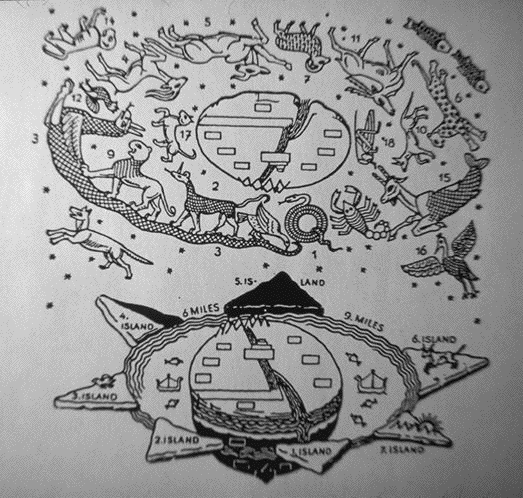 These divine animal constellations which dwell in the Heavenly Ocean are there
named the departed gods (in another cuneiform document they are referred to as the
gods of the night and the goddesses of the night) because they were derived from the
earlier "vanished" gods of the Sumerians, which, as the result of a reform in prehistoric
times, were deposed and replaced by human gods. The Sumerian Epic of Creation is the
acknowledgment of this reform. This reform is also the subject of Nimrod's revolt against
'the gods' (more than one). The vanished gods are also refered to as 'fallen angels' and
their children are called 'The Nephilim' in the bible.
These divine animal constellations which dwell in the Heavenly Ocean are there
named the departed gods (in another cuneiform document they are referred to as the
gods of the night and the goddesses of the night) because they were derived from the
earlier "vanished" gods of the Sumerians, which, as the result of a reform in prehistoric
times, were deposed and replaced by human gods. The Sumerian Epic of Creation is the
acknowledgment of this reform. This reform is also the subject of Nimrod's revolt against
'the gods' (more than one). The vanished gods are also refered to as 'fallen angels' and
their children are called 'The Nephilim' in the bible.
The map is a link to more information about very ancient times. It names constellations
not known to man until the 9th century AD. But Enoch mentions the great star field of Orionos
(Orion) 8000 years before
we knew about it. Orion is also called 'The Hunter' and that designation is also assigned to
Nimrod. Curiously the Great Pyramid and it's two smaller partners are laid out on
the ground exactly matching the Stars in Orion's Belt. Four other pyramids are also found
matching the position of the four other stars in the constellation. Bordering constellations:
Gemini and Taurus. The Message of the Sphinx, by Robert Buval and Graham Hancock
explores the connections.
Historically the constellation Orion has had other names, perhaps the earliest known is the
Babylonian "Shepherd of Anu", corresponding to an apparent representation of the constellation
Auriga or an element of it, as a shepherd's crook.
Another galaxy mentioned is
Andromeda , and is 2.5
million light-years away. The earliest recorded observation of the Andromeda Galaxy was in
905 CE by the Persian astronomer 'Abd Al-Rahman Al Sufi, who described it as a "small cloud".
Star charts of that period have it labeled as the Little Cloud. The first description of the
object based on telescopic observation was given by Simon Marius. The first photographs
of this galaxy were taken in 1887 by Isaac Roberts. The photographs of the galaxy remind us of just
how small we really are.
Genesis seems to suggest that the Patriarchs lived in isolation from the rest
of the world, but in historical fact they shared with the Babylonians, Egyptians,
Canaanites, Hittites, and Cretans a common Mediterranean culture fermented by
philosophers from India, even distant Britain. Although the written records of this
age are lost, some trade items help us deduce that this may have been so. The
Quich'e language of Old Mexico had close affinity with ancient Hebrew. The religion
and architecture of Babylon evoked prehistoric Peru; Menes, the son of Nimrod,
in 2275 B.C. had made a voyage from Sumer to the Sunset Land. Mariners from
Crete reached North and South America, followed by proto-Phoenicians from Lagash
in the Persian Gulf. Lagash was an ancient city of Sumer in southern Mesopotamia.
It flourished c. 2,400 B.C. and after the fall of Akkad (2,180) it enjoyed a classical
revival in its sculpture and literature. A rare Egyptian papyrus mentions Central
Russia, the Zambesi, and Indonesia; hieroglyphics from Egypt are said to be found
near Sydney, Australia." The quote above is from "God and Spacemen of the
Ancient Past" W. Raymond Drake, Chapter 13 "Abraham" page 157-174.
Next...Hiram Introduction 2...
Myth transformed into actual fact: The Gods
of Babylonia

Back to The main page
A variety of subjects all relating to ancient Masonic secrets are
covered on the 'intro pages' but are covered in depth on other pages within the site. The
following is an overview of what's on the next/previous 11 listed pages.
Hiram - Forward
Hiram - Forward 1
The Two Pillars that Noah found. Focus of the 24th through
the 28th degree. The 10,000 year old "10 Commandments. How the 'Watchers' married human
women and corrupted mankind.The real Exodus. The eruption of the Santarini
Volcano and it's connection to the 10 plagues of Egypt. The Egyptian Gods, Historical evidence
proves there were two ruling Kings at the same time in Egypt. One was Seqenenre Tao II who
may have been the last man to know the secret name of God. Many secrets of the ancients.
What was Manna?
Hiram - Forward 2
The megatsunami that caused Noah's Flood, Archaeology places doubt on biblical
history, How did man come to know science, writing, mathmetics,
grammer, astrology, ect.? "Craft Masonry", how it began, Agriculture, Farming and animal husbantry
taught to man by who? Biblical text 'copied from an earlier source,
The 'One God' theory is of a late date, Astrology, predictions to our destruction? The 13th
sign, the 10th planet, Humanity has forgotten where we came from, The
secret word of a Master Mason, Masonic legend of Hiram Abiff, Where did Religion began?,
Deities that have the same attributes as Jesus. Disclaimer.
Hiram - Forward 3
Ham, Cush, and Miziram lived in Egypt. Is Cush the Scorpion King?,
Shem and Japheth invade Egypt in the predynastic era, Abraham, and Jacob are Hyksos and
invaders of Egypt in the 12 to 16th dynasty. Dynasty Tables provided by
professionals on Egyptology and Egyptian history. Why the Thera volcanic
eruption is connected with the Exodus and the 10 plagues, The sacred city of 'On',
Discovery of 'Jacob's' seal-ring at Avaris. Ancient 'King' list,
Ham's clan become the Dynastic Kings of Egypt. They take on Egyptian names,
How the use of the word 'pharoah' came about. The Set(h) and Horus Gods,
Secret knowledge found in the book of Jasher, Canaan becomes the slave of Shem,
Who is 'US'? Who are the elohim?, The first builders,
The spread of science and philosophy,
Hiram Index 1
The Egyptians wore masonic aprons, The 10 commandments came from the Egyptrian Book of the Dead,
More 'lost gospels', The journey of Death leads to NDE, Thoth and Enoch, The Master Teacher Enoch,
Another God found in the Book of Jasher, The bible
borrowed text from Sumerian sources. Joseph did not live at Thebes,
Moses story copied from the story of Sargon, review of the Hiram Key, more secret
knowledge and science, Moses promoted the Essene teachings, The
magical Sapphire rod of Elohim, The Djed Pillars-a possible light source.
Hiram Index 2
The sons of Noah, Proof Ham and his sons were caucasian. Canaan's curse.
Ham's clan moves to Egypt around 3200 BC. Conections between Ham and the Egyptians.
The legend of Tiamat..our Earth. The mountain of Moses and it's secrets and the Goddess he surported.
The 18 books missing from the bible. Religious freedom - an Arab Lady
speeks out.. What Enoch was taught. The rejection of Science and knowledge by the church.
Hiram Index 3
Religious oppression and the corrupt priesthood of Israel. The Secret Doctrine. The source of
authority is spiritual. What the church claimed was heretical. The scientists.
The "Mystery Schools" - ancient scientific papyrus - secret books. Who are the Nephilim?
Solomon's tribute to Wisdom. Physics, angels, Magicians, and the supernatural.
Hiram Index 4
The conception of Noah, Church opposition to science,
Historical and biblical evidence for 2 gods. Joseph, pharoah of Memphis/Avaris.
Noah and his sons. How did Nimrod become a king of Egypt? The ziggurat (Tower of Babel)
ruins of Eridu. The predynasties of Egypt, Sacred ancient texts left out of the bible give the names
of Hebrew Kings in another language. Shem became a ursurper King, then Abraham. The legendary
battle of Set and Horus becomes a real historical event called the 1st Pyramid War. Ham rules in the
first dynasty of Egypt.
Hiram Index 5
The tribes of the Giants. Who brought the flood on mankind?.
The old Babyloian Gods. The Egyptian Gods, What does astrology have to do with it?. The true cross.
The diverse cultures and races of the World, Thoth becomes Quetzalcoatl and moved to the high
Andes mountains. Giants in South America. Cain in South America?. Rocket
Ships of the Ancients. The Toltech and Maya civilization
Hiram Index 6
The famous Narmer Palette and it's connection to Nimrod. How did Narmar
become associated with Nimrod? Before the Flood, the Book of Noah, Here
we see the punishing god, 'The Lord of Spirits'. We introduce one of the Gods in Sumerian myth,
Where did Solomon get 'the secrets'? Enki, the lord of magic, Atlantian
(Etruscan) Couple - 7th century BC, Rebuilt after the flood, are the Apsu and the Tower of Babel
the same thing, Eridu (or Eridug, modern Tell Abu Shahrain, Iraq) was the earliest city in southern
Mesopotamia, founded ca. 5400 BC. The Sky Gods, The immortals
or 'Good Watchers', The Kings of Uruk and Ur, A collection of Aeramic writings called The Targum,
What you don't know about Abraham. The oldest culture in the world, Noah is
taken to the abode of the gods.
Hiram Introduction 1...
Religious symbols. Ancient History, which shows two ruling classes in Egypt. One was refered to as Hyksos.
These people became the Hebrews. Documentation from 3 sources put the Israelites in a 'bad light'.
Exerpts from the Nag Hammidi Scrolls, The Elohim, Who is "US" in Genesis?
Hiram Introduction 1 continued
The Inventory Stella of Khufu proves the Great Pyramid was not built by him.
The meaning of "Light". Science was regarded as an outcast, an enemy. There was no liberty,
no education, no philosophy, no science; nothing but credulity, ignorance, and superstition.
Christianity removed learning and education from civilization..This is how they did it!
The Melchizedek priesthood. Armageddon! Gnosticism as taught by the disciples. Focus
of the 23rd and 24th degree Scottish Rite. The White haired stranger.
The invention of the 'Devil'. Archaeology and the Babylonian Captivity of the Jews.
Hiram Introduction 2
Civilization begins again after the Flood, The famous library of Ashurbanipal with 22,000 inscribed clay
tablets,The cruelty of God, Religion breeds terrors of all sorts, The Dark side of Religion, The Temples
of the Gods, Hammurabi's Code, Eridu, also called Eridug, was the first city in the world, The Children
of the Rocketships, After the Great Flood, The two sons of Noah who turned to 'different gods',
The Egyptian Gods of Ham's clan, The predynastic period of the falcon cult, the defleshed bones of
Nebkara, Hotepsekhemwy/Raneb has been associated with Jacob, the sacred goat of Mendes,
precession of the ages and Astronomical signs, The Age of Aquarius, Enki's lineage's domain, the
temple complex of Baalbek
Hiram Introduction 3
The Keys of Enoch. Jesus' miracles; was Lazerus really raised form
the dead? The 'Great White Brotherhood, Assended Masters, What is the church hiding?
A compairson between Jesus and Dionysus, How women became whores in the churche's eye,
Evidence that Jesus was in India, James, brother of Jesus - who was his father?
Hiram Introduction 4
More mysteries, "US", Elohim, Jehovah, Hashem, Egyptian Gods,The Mithans or Snake people, The
Shemsu Hor, the maltaskulls, The Code of Hammurabi (Codex Hammurabi), The writings of Timaeus,
reconstruction of the Etemenanki or the Tower of Babel, High Priesthood of Zadok, The spread of
science and philosophy, Science in the Middle Ages, A God of Science, Religion and politics don't mix.,
Messianics, priest in charge of over-seeing magical rites,
Hiram Introduction 5
Brief story about the Knights Templar, the church and freedom to 'choose'.
A link to the books left out of the Bible. The Cooke Manuscript. The Regius Manuscript. The 'Pillers' of secrets.
Ham and the Tower of Babel. The secret of Lazarus' raising from the dead.
The nuclear bombing of Sodom and Gomorrah in ancient times, where the Dead Sea tested positive
for radioactive materials 2000 years after Abraham left.
Hiram Introduction 6
Enki's organisation of the World, Uruk(Ur) where civilization began, Enlil gives all the "Me's" to Enki, overview
of Enlil and Enki's role, Enki's love and care for human kind, The Heliocentric System, the 'flat Earth'
system of the church, Galileo defended heliocentrism, Antikythera Mechanism, The Mysterious Divine,
The Gnostics, cathedrals built by the Templars using geometry and numerology,
The philosophic Secret
was then born in the form of social morality clothed in working-class allegory, The use of pi in the
Great Pyramid, Former President Anwar Sadat killed because he was a mason, Greek Philosopher
and Mathematician, Pythadoras taught geometry in 569 - 475 BC, Pythagorean Theorem,
Beneath the Temple of Hathor a secret lays, the ancient Shimar
or Schamir, The face of Serapis was used by the church as the image
of Jesus.
Or Forbidden Knowledge Forward
Religious Wars..Why?
Or The Widow's Son
Masonic Information
Forbidden Knowledge
The 10th Planet.
Or Site Map
 "I may not agree with
what you have to say, but I will defend to the death, your right to say it."
"I may not agree with
what you have to say, but I will defend to the death, your right to say it."
NO PART OF THIS SITE MAY BE COPIED, TRANSMITTED OR REPRODUCED, IN WHOLE OR IN PART,
WITHOUT THE EXPRESS WRITTEN PERMISSION OF THE WEBMASTER...
© COPYRIGHT 1999 - 2010 C.I.Case. ALL RIGHTS RESERVED.